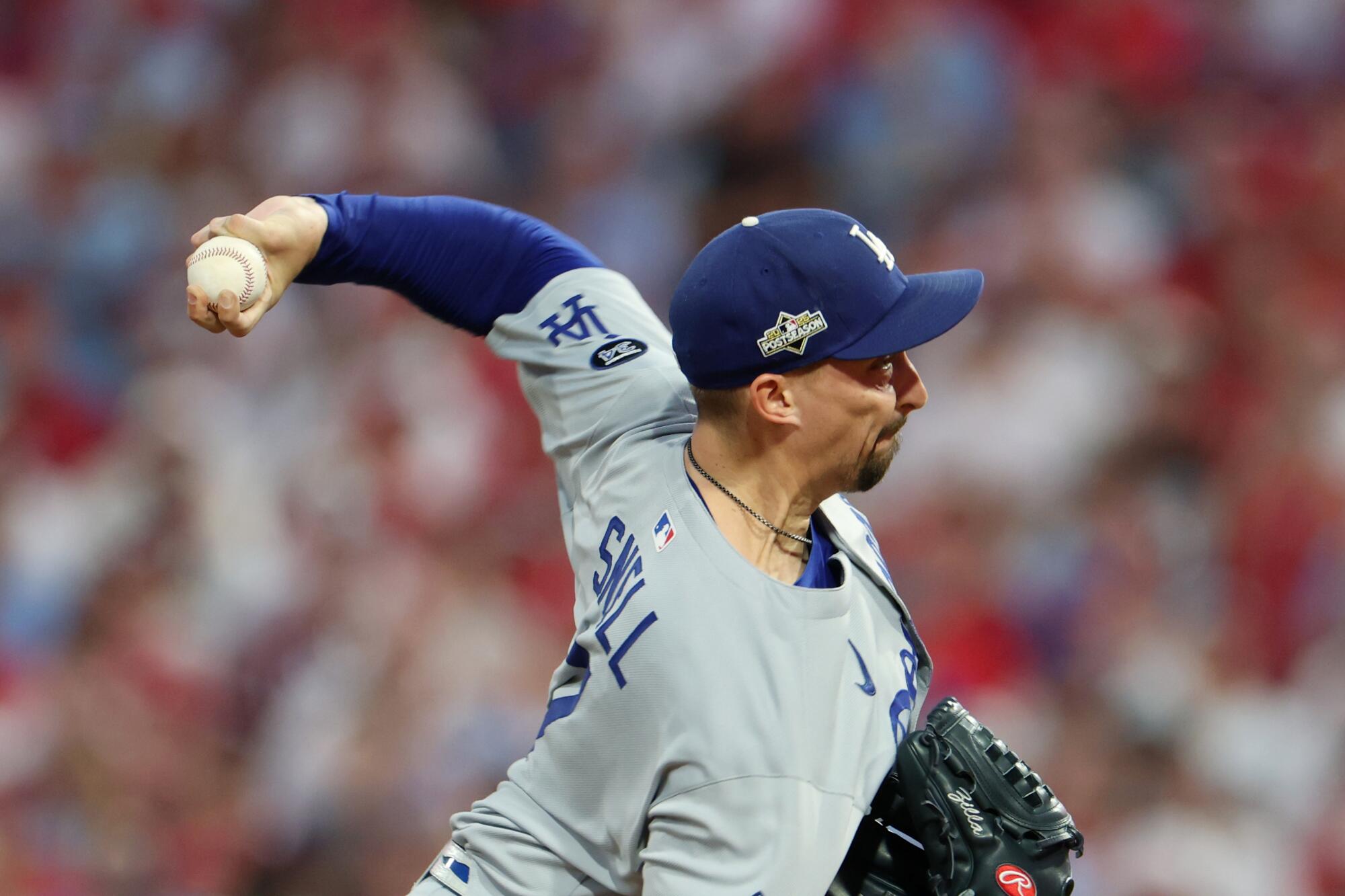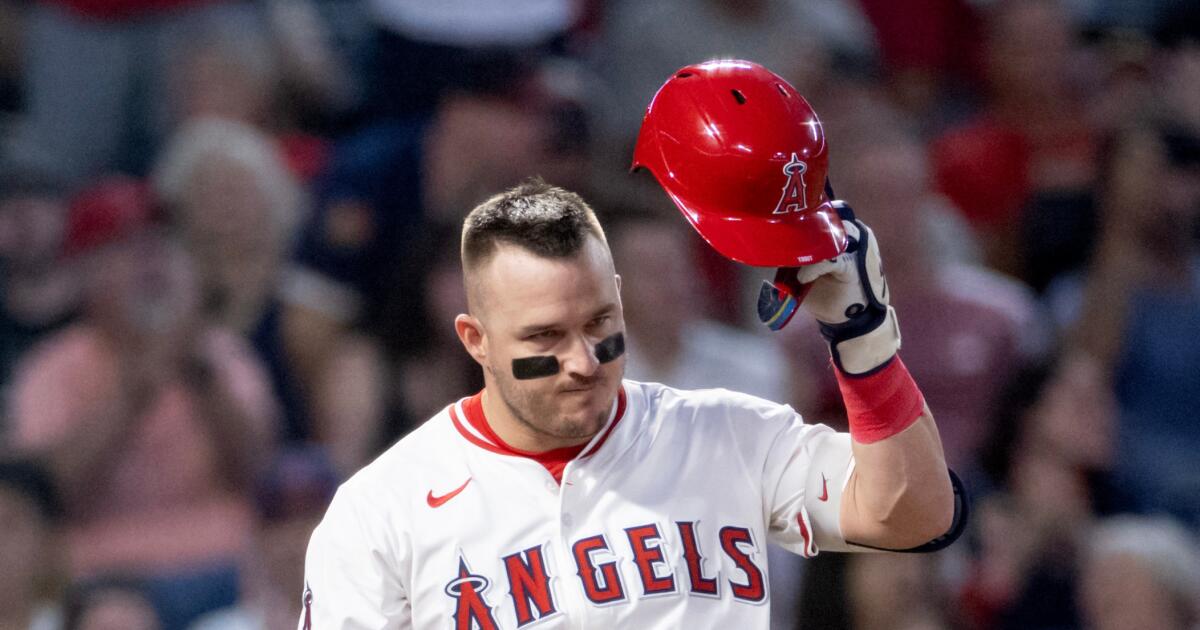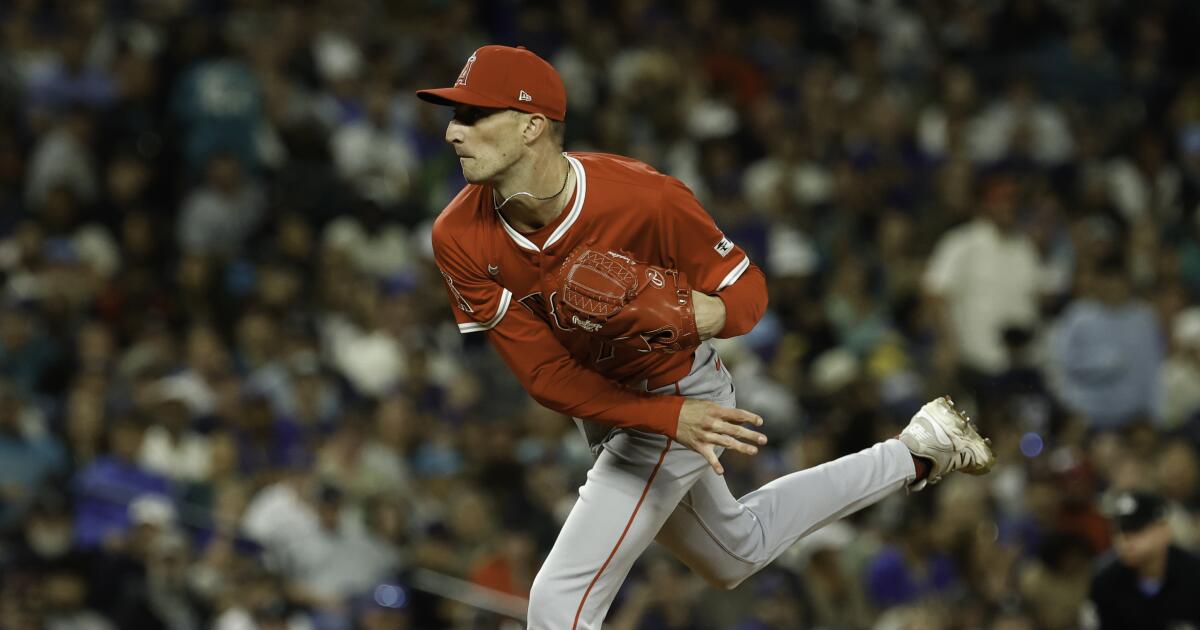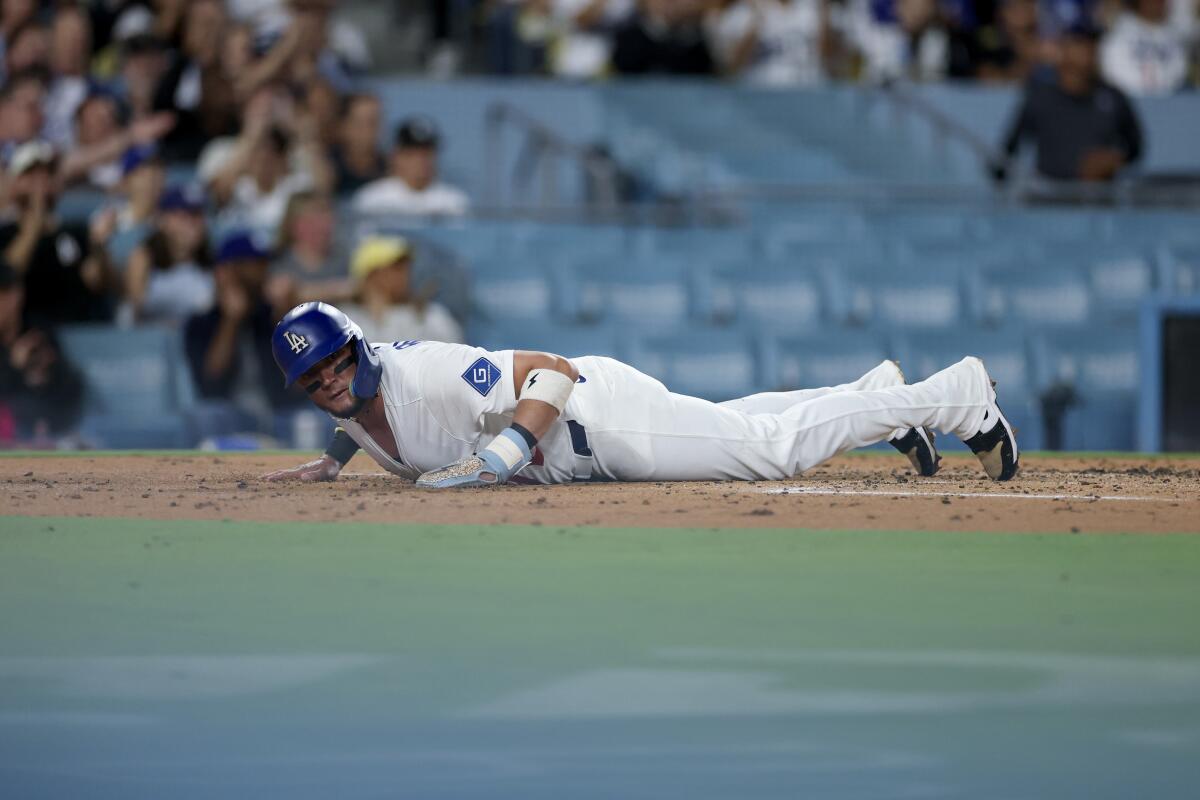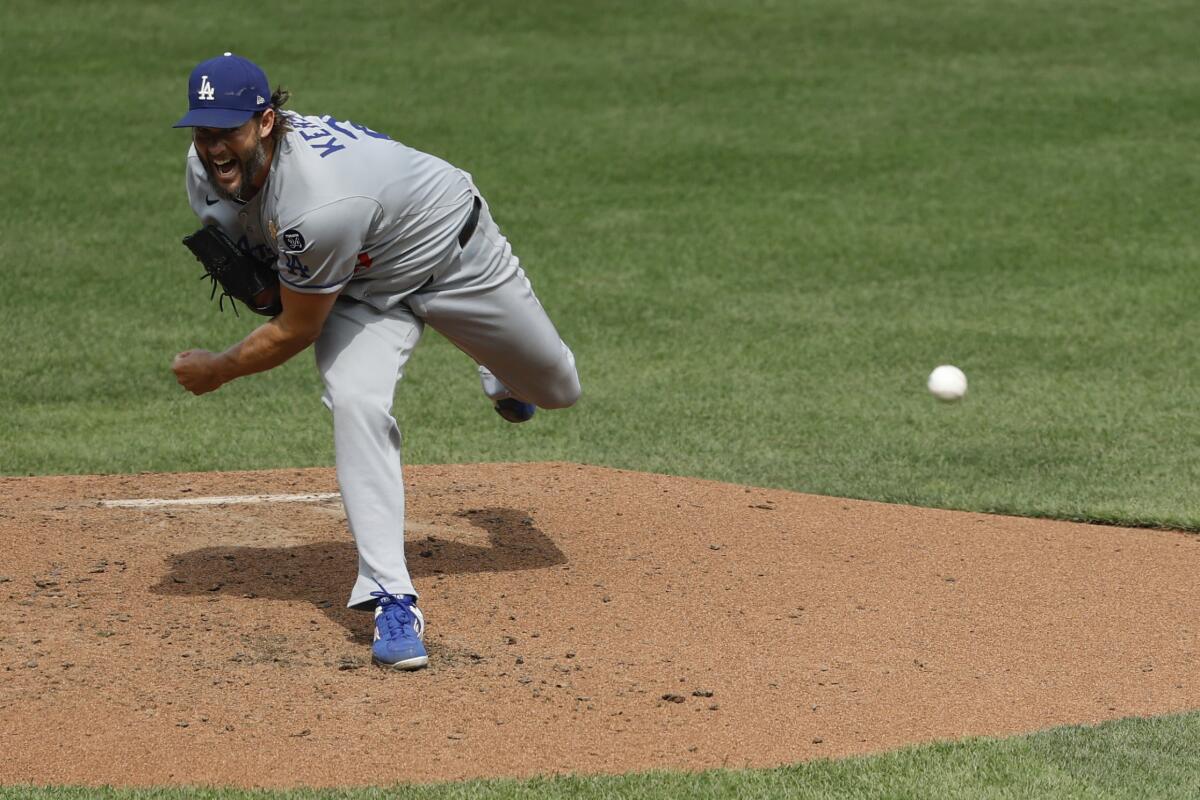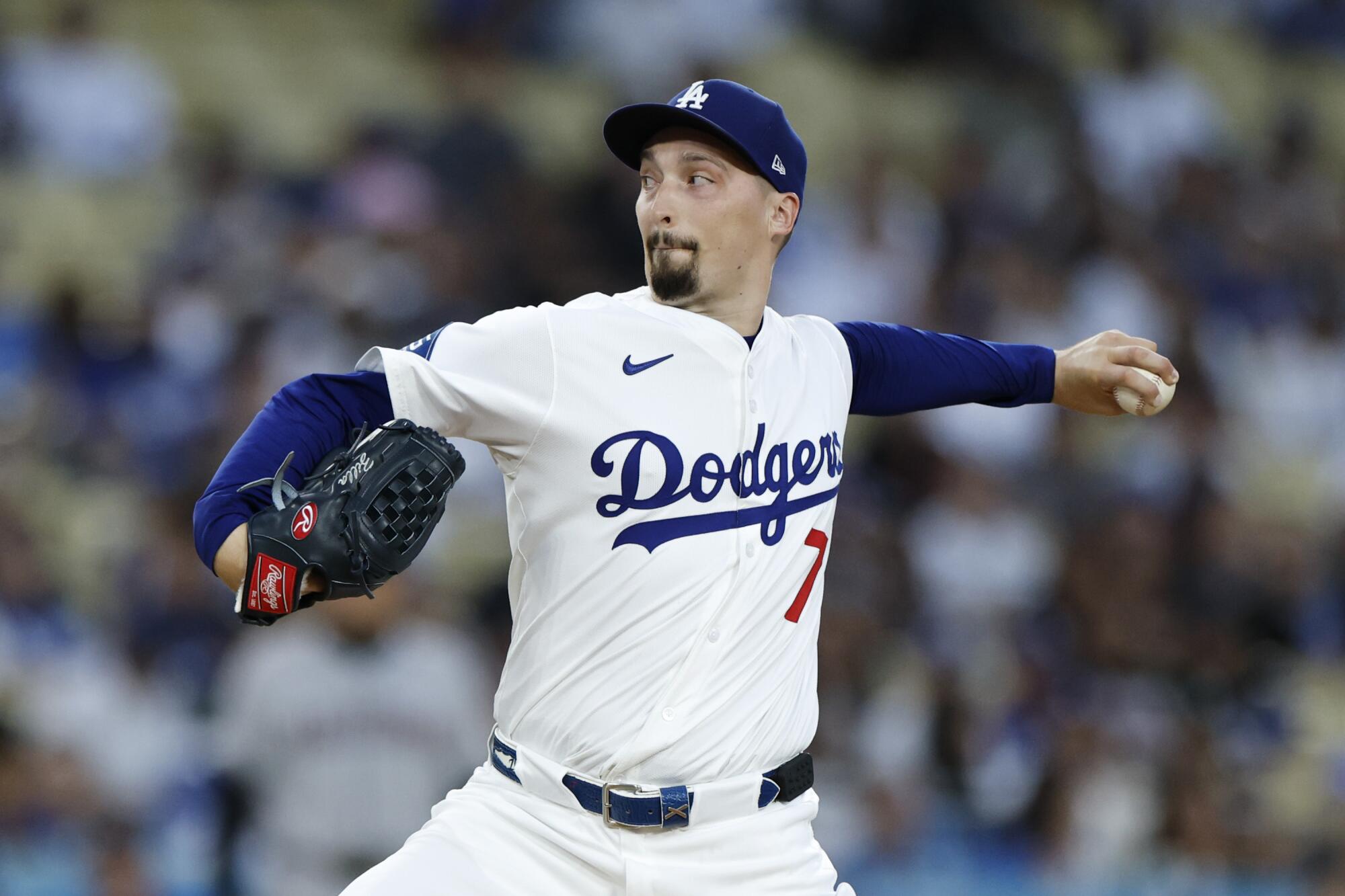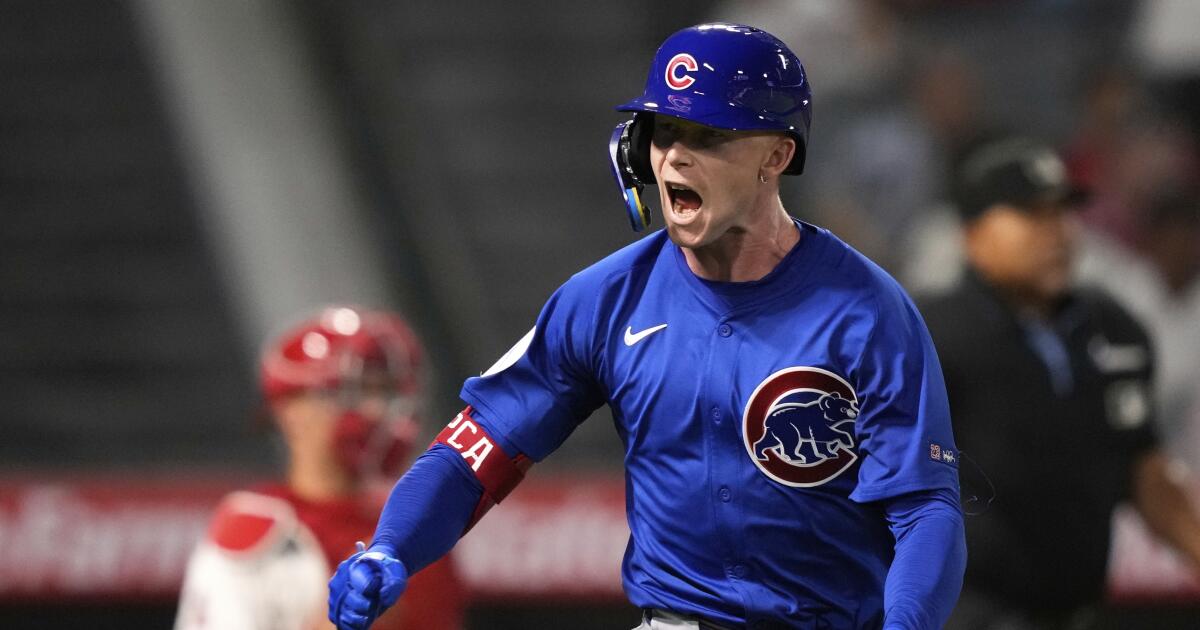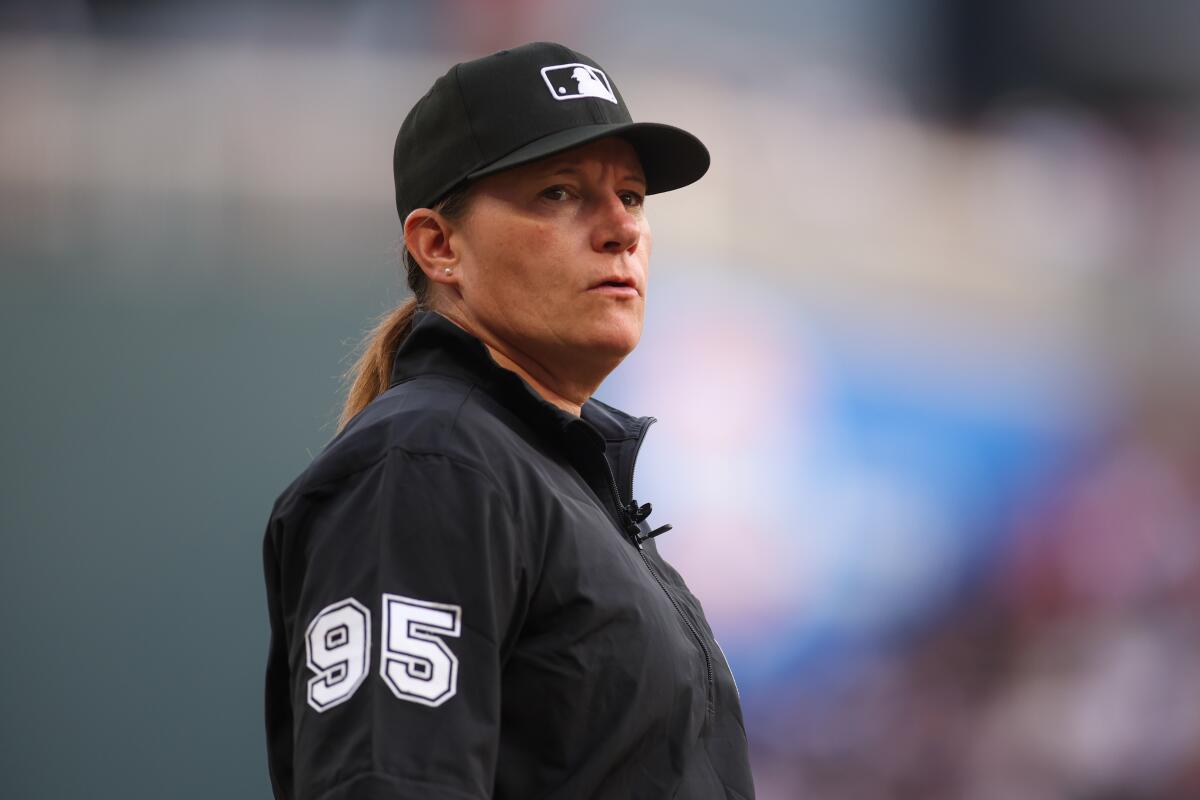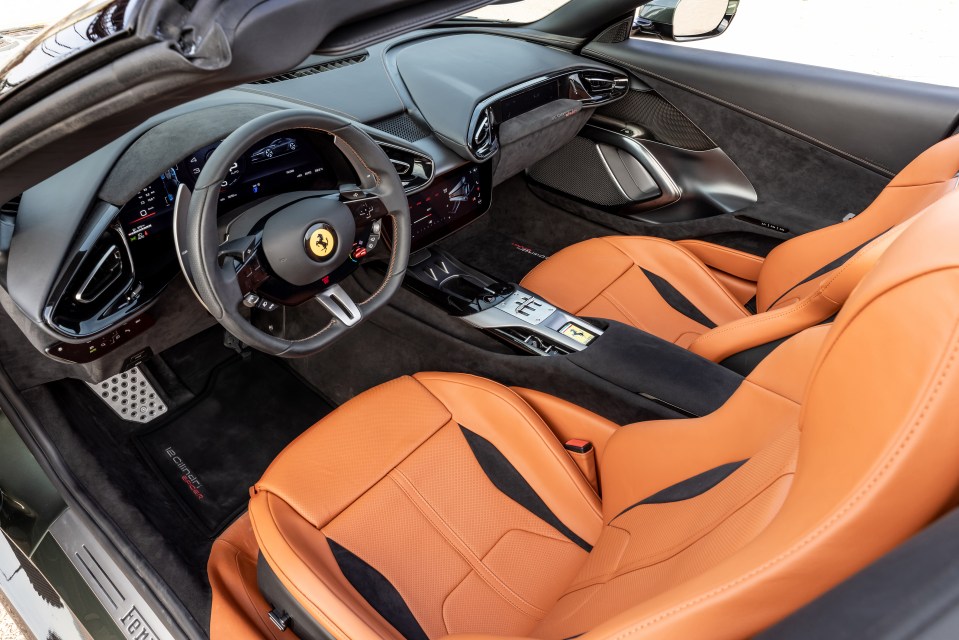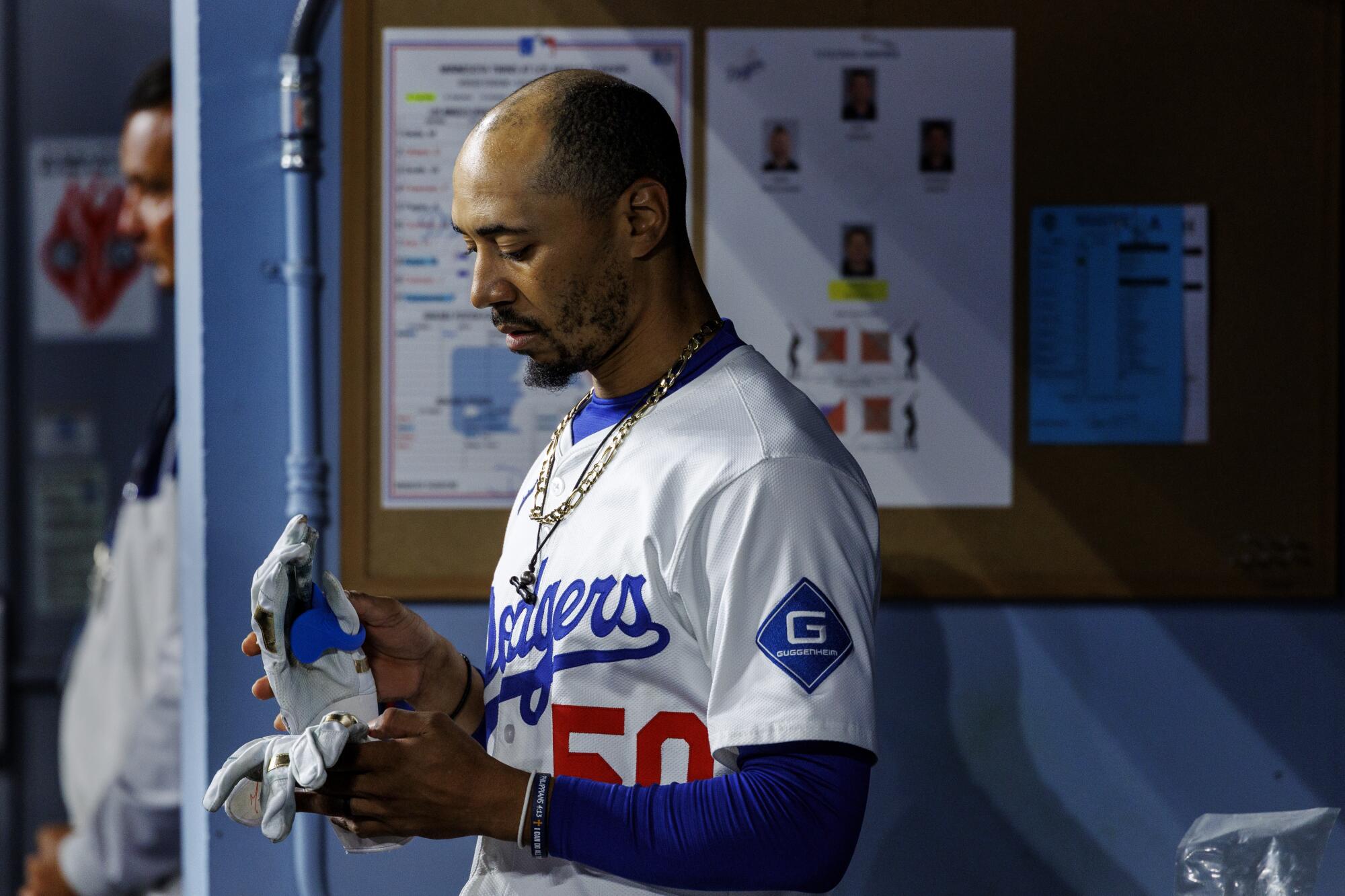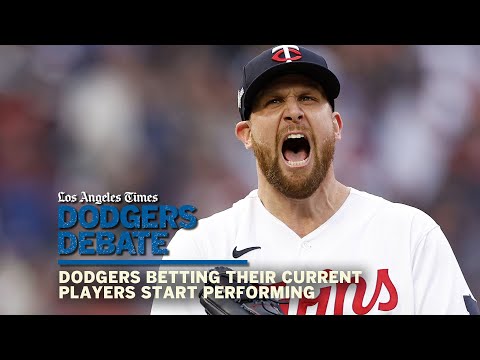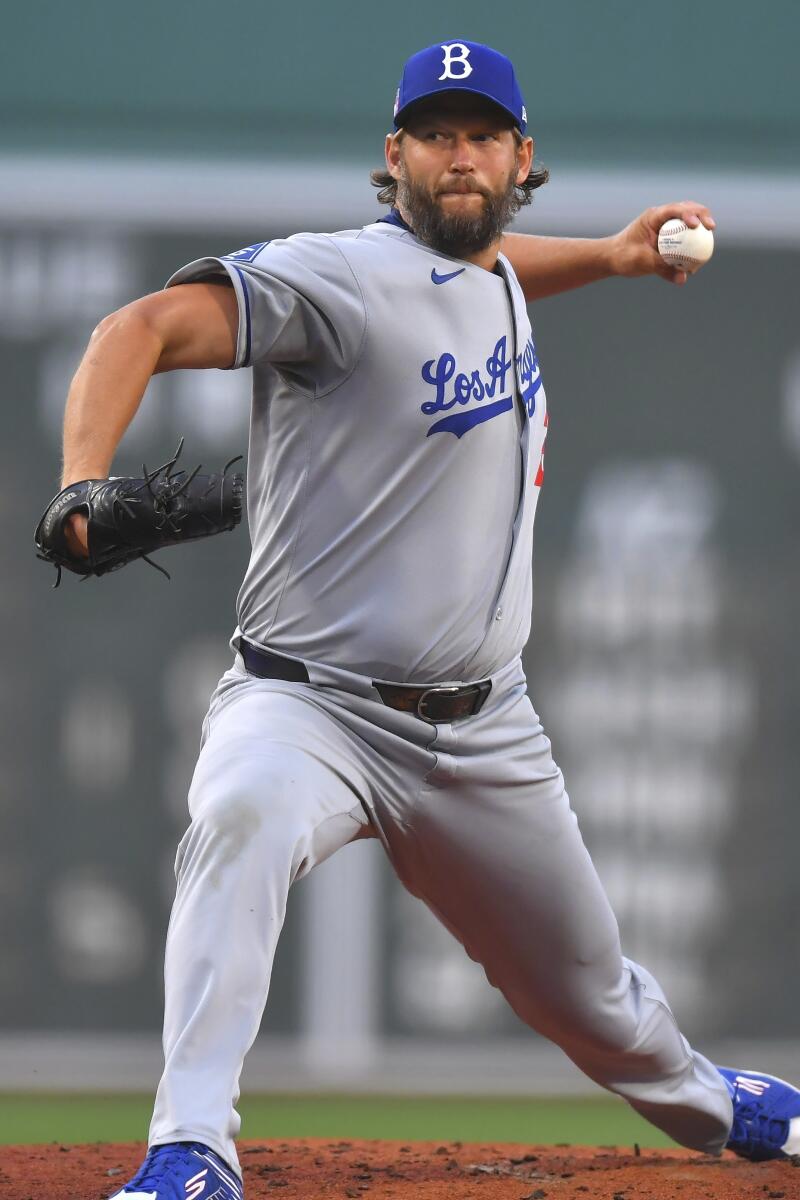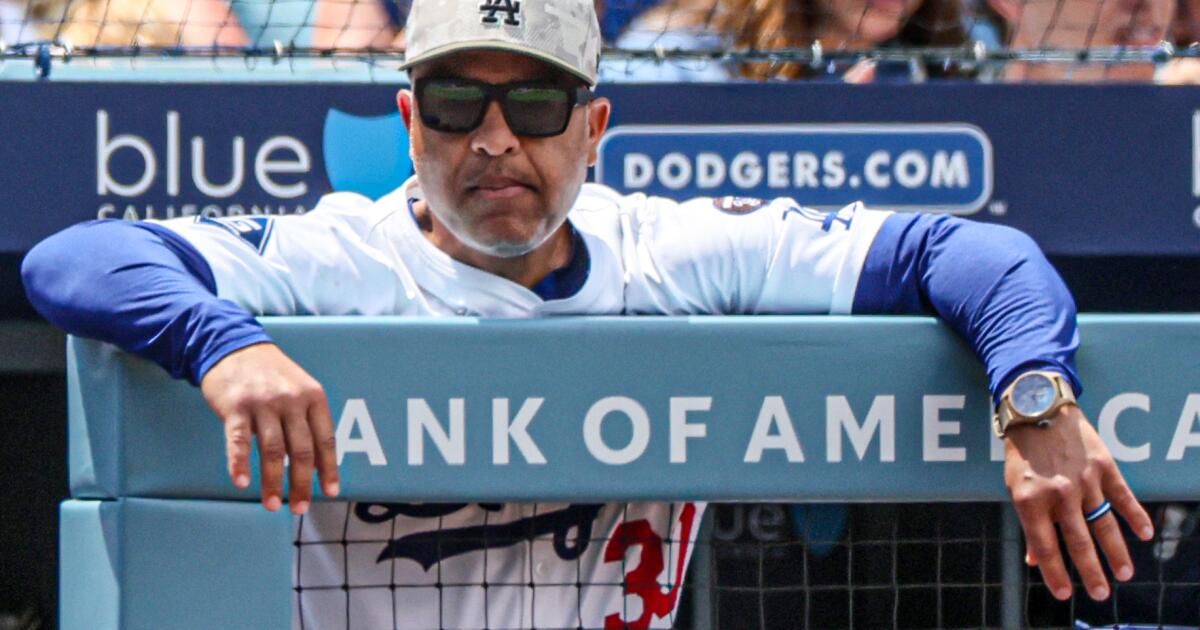Shohei Ohtani’s unprecedented night leads Dodgers back to World Series
Two days ago, Shohei Ohtani rolled into Dodger Stadium as a man on a mission.
After struggling for the previous couple weeks — mired in a postseason slump that had raised questions about everything from his out-of-sync swing mechanics to the physical toll of his two-way duties — the soon-to-be four-time MVP decided it was time to change something up.
Over the previous seven games, going back to the start of the National League Division Series, the $700-million man had looked nothing like himself. Ohtani had two hits in 25 at-bats. He’d recorded 12 strikeouts and plenty more puzzling swing decisions. And he seemed, in the estimation of some around the team, unusually perturbed as public criticisms of his play started to mount.
So, during the team’s off-day workout Wednesday at Dodger Stadium, ahead of Game 3 of the NL Championship Series, Ohtani informed the club’s hitting coaches he wanted to take batting practice on the field.
It was a change from his normal routine — and signaled his growing urgency to get back on track.
“If this was a regular-season situation and you’re looking at an expanse of small sample — eight, nine games, whatever it might be — he probably wouldn’t be out on the field,” manager Dave Roberts said later.
But “with the urgency [of] the postseason,” the manager continued, Ohtani “wanted to make an adjustment on his own.”
Whatever Ohtani found that day, evidently (and resoundingly) clicked. He led off Game 3 with a triple. He entered Game 4 looking more comfortable with his swing. And then, in one of the incredible individual displays ever witnessed in playoff history, he lifted the Dodgers straight into the World Series.
In a 5-1 defeat of the Milwaukee Brewers that completed an NLCS sweep and gave the Dodgers their 26th pennant in franchise history, Ohtani hit three home runs as a hitter, and struck out 10 batters over six-plus scoreless innings as a pitcher.
Shohei Ohtani pitches during Game 4 of the NLCS against the Brewers. Ohtani struck out 10 over six scoreless innings for the Dodgers.
(Gina Ferazzi / Los Angeles Times)
He made his previously disappointing playoffs a suddenly forgotten memory, earning NLCS MVP honors and to the astonished amazement of all 52,883 in attendance.
And he delivered the kind of game the baseball world dreamed about when the two-way phenom first arrived from Japan, fulfilling the prophecy that accompanied him as a near-mythical prospect eight years earlier.
Back then, Ohtani’s 100-mph fastball and wicked off-speed repertoire had tantalized evaluators. His majestic left-handed swing had tortured pitchers in his home country.
Not since Babe Ruth had the sport seen anything like him.
There were some early growing pains (and injuries) during his transition to the majors. But over the last five years, he blossomed in the game’s definitive face.

A look at the three home runs Shohei Ohtani hit in Game 4 of the NLCS on Friday.
All that had been missing, in a resume chock full of MVPs and All-Star selections and unthinkable records even “The Great Bambino” never produced, was a signature performance in October. A game in which he dominated on the mound, thrilled at the plate, and single-handedly transformed a game on the sport’s biggest stage.
During that Wednesday workout this week, Ohtani got himself ready for one, stepping into the cage during his on-field batting practice — as his walk-up song played through the stadium speakers and teammates gathered near the dugout in curious anticipation — and swatting one home run after another, including one that soared to the roof of the right-field pavilion.
On Friday, in an almost unimaginable showcase of his unprecedented talents, he managed to do exactly the same thing.
After stranding a leadoff walk in the top of the first with three-straight strikeouts, Ohtani switched from pitcher to hitter and unleashed a hellacious swing. Brewers starter José Quintana left him an inside slurve. Ohtani turned it into the first leadoff home run ever by a pitcher (in the regular season or playoffs). The ball traveled 446 feet. It landed high up the right-field stands.

Three more scoreless innings of pitching work later, Ohtani came back to the plate and hit his second home run of the night even farther. In a swing almost identical to his titanic BP drive two days prior, he launched a ball that darn near clipped the pavilion roof again, a 469-foot moonshot that landed in the concourse above the seats in right.
Somehow, there was still plenty more to come.
With the Dodgers up 4-0 at that point, Ohtani then did his best work as a pitcher, following up two strikeouts that stranded a leadoff double in the fourth — and had him excitedly fist-pumping off the mound — with two more in both the fifth and the sixth.
His fastball was humming up to triple-digits. His sweeper and cutter were keeping the Brewers off balance. His splitter wasn’t touched once any of the five times they tried to swing at it.
Shohei Ohtani runs the bases after hitting his third home run of the game against the Brewers in Game 4 of the NLCS at Dodger Stadium on Friday night.
(Gina Ferazzi/Los Angeles Times)
Anything he did immediately became magic.
Ohtani’s loudest roar came in the bottom of the seventh, after his pitching start had ended on a walk and a single led off the top half of the inning.
For the third time, he flung his bat at a pitch over the plate. He sent a fly ball sailing deep in a mild autumn night. He rounded the bases as landed beyond the center field fence.
Three home runs. Six immaculate innings. A tour de force that sent the Dodgers to the World Series.
All of it, just two days removed from Ohtani being seemingly at his lowest.
All of it, when the baseball world was most closely watching.
Dodgers players and coaches celebrate after sweeping the Milwaukee Brewers in the NLCS at Dodger Stadium on Friday night.
(Robert Gauthier / Los Angeles Times)
Shohei Ohtani takes rare on-field BP amid playoff slump, downplays impact of two-way role
At 5:37 p.m. Wednesday, Michael Buble’s “Feeling Good” blared from the Dodger Stadium speakers.
Shohei Ohtani came strolling to the plate with a bat in his hands.
There was no one in the stands, of course. Nor an opposing pitcher on the mound. The Dodgers, on this workout day after returning from Milwaukee, were still some 22 hours away from resuming their National League Championship Series against the Brewers. For any other player, it would have been a routine affair.
Ohtani, however, is not just any player.
And among the many things that make him unique, his habit of almost never taking batting practice on the field is one of the small but notable ones.
Which made his decision to do so Wednesday a telling development.
Over the last two weeks, Ohtani has been in a slump. Since the start of the NL Division Series, he is just two-for-25 with a whopping 12 strikeouts. He has been smothered by left-handed pitching. He has made poor swing decisions and failed to slug the ball.
Last week, manager Dave Roberts went so far as to say the Dodgers were “not gonna win the World Series with that sort of performance” from their $700-million slugger.
Thus, out Ohtani came for batting practice on Wednesday in the most visible sign yet of his urgency for a turnaround.
“The other way to say it is that, if I hit, we will win,” Ohtani said in Japanese when asked about Roberts’ World Series quote earlier Wednesday afternoon. “I think he thinks that if I hit, we will win. I’d like to do my best to do that.”
In Roberts’ view, Ohtani has already started improving from his woeful NLDS, when he struck out nine times in 18 trips to the plate against a left-handed-heavy Philadelphia Phillies staff that, as president of baseball operations Andrew Friedman emphatically put it, had “the most impressive execution against a hitter I’ve ever seen.”
In Game 1 of the NLCS against the Brewers, Ohtani was 0-for-two but walked three times; twice intentionally but another on a more disciplined five-pitch at-bat to lead off the game against left-handed opener Aaron Ashby.
The following night, he went only one-for-five with three more strikeouts, giving him 15 this postseason, second-most in the playoffs. But he did have an RBI single, marking his first run driven in since Game 2 of the NLDS. He followed that with a steal, swiping his first bag of the playoffs. And earlier in the game, he scorched a lineout to right at 115.2 mph, the hardest he’d hit a ball since taking Cincinnati Reds pitcher Hunter Greene deep in the team’s postseason opener.
“The first two games in Milwaukee, his at-bats have been fantastic,” Roberts said Wednesday, before heading out to the field and watching Ohtani’s impromptu BP session.
“That’s what I’ve been looking for. That’s what I’m counting on,” he added, while noting the careful approach the Brewers have also taken with the soon-to-be four-time MVP. “You can only take what they give you. So for me, I think he’s in a good spot right now.”
Shohei Ohtani puts the ball in play in the third inning during Game 4 of the NLDS.
(Gina Ferazzi / Los Angeles Times)
Ohtani’s overall numbers, of course, continue to suggest otherwise. His .147 postseason batting average is second-worst on the team, ahead of only Andy Pages. His seven-game drought without an extra-base hit is longer than any he endured in the regular season.
“The first thing I have to do is increase the level of my at-bats,” Ohtani said in Japanese. “Swing at strikes and not swing at balls.”
On Wednesday, Ohtani’s slump also led to questions about his role as a two-way player, and whether his return to pitching this season (and, this October, doing it for the first time in the playoffs) has contributed to his sudden struggles at the plate.
After all, on days Ohtani pitched this season, he hit .222 with four home runs but 21 strikeouts. On the days immediately following an outing, he batted .147 with two home runs and 10 strikeouts.
His current slump began with a hitless, four-strikeout dud in Game 1 of the NLDS, when he also made a six-inning, three-run start on the mound.
And in days since, Roberts has acknowledged some likely correlation between Ohtani’s two roles.
“[His offense] hasn’t been good when he’s pitched,” Roberts said following the NLDS. “We’ve got to think through this and come up with a better game plan.”
Ohtani, on the other hand, pushed back somewhat on that narrative during Wednesday’s workout, in which he also threw a bullpen session in preparation for his next start in Game 4 of the NLCS on Friday.
While it is “more physically strenuous” to handle both roles, he conceded, he countered that “I don’t know if there’s a direct correlation.”
“Physically,” he added, “I don’t feel like there’s a connection.”
Instead, Ohtani on Wednesday went about fixing his swing the way any other normal hitter would. He went out on the field for his rare session of batting practice. Of his 32 swings, he sent 14 over the fence, including one that clanked off the roof of the right-field pavilion.
“Certainly, there’s frustration,” Roberts said of how he’s seen Ohtani handle his uncharacteristic lack of performance.
But, he added, “that’s expected. I don’t mind it. I like the edge.”
“He’s obviously a very, very talented player, and we’re counting on him,” Roberts continued. “He’s just a great competitor. He’s very prepared. And there’s still a lot of baseball left.”
Can Shohei Ohtani find it in NLCS? ‘At-bat quality needs to get better’
When Shohei Ohtani was asked about his woeful performance at the plate in the Dodgers’ National League Division Series against the Philadelphia Phillies last week, he first gave credit to the opposition.
Then, after a series that saw the Phillies counter him with one left-handed pitcher after the next, he was also quick to point out that he wasn’t alone.
“It was pretty difficult for left-handed hitters,” Ohtani said in Japanese amid the Dodgers’ clubhouse celebration following their Game 4 victory. “This was also the case for Freddie [Freeman].”
The Phillies did indeed make life tough on the Dodgers’ best lefty bats.
Freeman was only three for 15 in the series, albeit with a key Game 2 double and a .294 on-base-percentage.
Max Muncy was four for nine in the series, but spent most of it waiting on the bench, not getting a start in any of the three contests the Phillies had a southpaw on the mound.
And as a team, the Dodgers hit just .199 with 41 strikeouts in the four-game series.
However, no one’s struggles were as pronounced as Ohtani’s — the soon-to-be four-time MVP winner, who in the NLDS looked like anything but.
Ohtani struck out in each of his first four at-bats in Game 1. He didn’t get his first hit until grounding an RBI single through the infield in the seventh inning of Game 2.
After that, Ohtani’s only other time reaching base safely was when the Phillies intentionally walked him in the seventh inning of Game 4.
His final stat line from the series: One for 18, nine strikeouts and a whole lot of questions about what went wrong.
Ohtani, who was coming off a three-hit, two-homer wild-card round, did acknowledge Thursday night that “there were at-bats that didn’t go the way I thought they would.”
But, he quickly added: “The opposing pitchers didn’t make many mistakes. They pitched wonderfully, in a way that’s worthy for the postseason. There were a lot of games like that for both teams.”
The real question coming out of the series was about the root cause of Ohtani’s unexpected struggles.
Was it simply because of the tough pitching matchups, having faced a lefty in 12 of his 20 trips to the plate? Or had his faltering approach created more legitimate concerns, the kind that could threaten to continue into the NL Championship Series?

“I think a lot of it actually was driven by the left-handed pitching,” manager Dave Roberts said Saturday, as the Dodgers awaited to face either the Chicago Cubs or Milwaukee Brewers in an NLCS that will begin on Monday.
However, the manager also put the onus on his $700-million superstar to be better.
“Hoping that he can do a little self-reflecting on that series, and how aggressive he was outside of the strike zone, passive in the zone,” Roberts said. “The at-bat quality needs to get better.”
For the Dodgers, the implications are stark.
“We’re not gonna win the World Series with that sort of performance,” Roberts continued. “So we’re counting on a recalibration, getting back into the strike zone.”
From the very first at-bat of Game 1 — when he was also the starting pitcher in his first career playoff game as a two-way player — Ohtani struggled to make the right swing decisions.
He chased three pitches off the inside of the plate from Phillies lefty Cristopher Sánchez, which Roberts felt “kinda set the tone” for his series-long struggles, then took a called third strike the next two times he faced him.
From there, the 31-year-old slugger could never seem to dial back into his approach.
He went down looking again in Game 1 against left-handed reliever Matt Strahm. He led off Game 2 with another strikeout against another lefty in Jesús Luzardo. On and on it went, with Ohtani continuing to chase inside junk, flailing at pitches that darted off the plate the other way, and finding his only reprieve in a rematch with Strahm in Game 2 when he got just enough on an inside sinker.
Roberts’ hope was that, moving forward, Ohtani would be able to learn and adjust.
“Understanding when he faces left-handed pitching, what they’re gonna try to do: Crowd him in, off, spin him away,” Roberts said. “He’s just gotta be better at managing the hitting zone. I’m counting on it. We’re all counting on it.”
Roberts also conceded that Ohtani’s at-bats on the day he pitched in Game 1 seemed to be especially rushed.
“[When] he’s pitching, he’s probably trying to conserve energy, not trying to get into at-bats,” Roberts said. “It hasn’t been good when he’s pitched. I do think that’s part of it. We’ve got to think through this and come up with a better game plan.”
After all, while Ohtani might not have been the only struggling hitter in the NLDS, his importance to the lineup is greater than anyone’s. The Dodgers can only endure without him for so long.
Dodgers lean on big inning to defeat Phillies and take 2-0 NLDS lead
PHILADELPHIA — It was quintessential October baseball.
Two starting pitchers dominating two helpless lineups.
A low-scoring contest in which every stranded baserunner felt like a monumental missed opportunity.
A nail-biting affair decided by one team cashing in a rare scoring chance, and the other failing to do the same.
In the bottom of the sixth inning in Game 2 of the National League Division Series on Monday, the Philadelphia Phillies had two aboard with one out, but came up empty.
In the next half-inning, the Dodgers faced the same situation, but came away with four runs.
That was the difference in the Dodgers’ 4-3 victory at Citizens Bank Park, giving them a commanding 2-0 lead in a best-of-five series that will shift to Dodger Stadium for Game 3 on Wednesday.
Dodgers pitcher Blake Snell delivers during the second inning Monday against the Phillies.
(Robert Gauthier / Los Angeles Times)
For most of Monday night, a crowd of 45,653 in South Philadelphia sat anxiously in anticipation, waiting for the dam to break in an old-fashioned pitchers’ duel.
On one side, Blake Snell was dotting his fastball up in the zone and to both parts of the plate, giving the Phillies little to hit while setting them up to flail at his dominant arsenal of secondary weapons. Through four innings, he retired 12 of 14 batters with only two walks issued. He had gotten whiffs on each of the first 11 non-fastballs he threw. And not until there were two outs in the fifth did he give up his first hit.
Opposite him, Jesús Luzardo was equally effective. After stranding runners on the corners in a shaky first, the left-hander locked in and made the Dodgers look silly with a barrage of sweepers and changeups that dipped below the zone. Where he needed 24 pitches in the first, he completed the next five on just 48 throws. In that time, he retired 17 in a row and let only two balls even leave the infield.
Finally, in the bottom of the sixth, the narrative began to change.
The Phillies generated the game’s first big opportunity, after Trea Turner and Kyle Schwarber walked in back-to-back at-bats against Snell with one out. It was the first time all night their lineup had gotten a runner past first. And it happened as two-time MVP Bryce Harper came strolling to the plate.
Snell’s plan of attack against Harper was simple. His first pitch was a slider in the dirt. His next was another one up in the zone Harper fouled off. Two more sliders followed, with Harper fanning on the first and fouling off the next. Then, after one change-of-pace curveball was buried in front of the plate, Snell went back to the slider one more time. It darted below Harper’s swing for a strikeout. Citizens Bank Park groaned.
The inning ended a batter later, when Alec Bohm chased a 2-and-0 changeup and hit a groundball to third base. Miguel Rojas fielded it behind the bag, clocked the speedy Bohm racing toward first, and decided to go the short — albeit risky — way instead, sprinting to third base and beating Turner to the bag with a headfirst slide.
That ended the inning. This time, frustrated boos rained down from the stands.

Minutes later, the Dodgers would be in front. Unlike the Phillies, they didn’t squander their one opportunity for runs.
Teoscar Hernández led off the top of the seventh with a single. Freddie Freeman followed with a line drive to weak-fielding Nick Castellanos (who was drawn into the Phillies’ lineup following an injury to Harrison Bader in Game 1) in right, getting on his horse to leg out a hustle double.
That knocked Luzardo out of the game. And in a move that would soon be second-guessed, Phillies manager Rob Thompson opted for right-handed reliever Orion Kerkering instead of dominant closer Jhoan Duran.
Kerkering got one quick out, striking out Tommy Edman.
But then Kiké Hernández hit a cue-ball grounder to Turner at shortstop. After a slight hesitation, Teoscar Hernández broke for home hard. As Turner fielded the ball and fired to the plate, Hernández chugged in with a feet-first slide. Catcher J.T. Realmuto’s tag was a split-second too late.
Teoscar Hernández celebrates after advancing to third on a double by Freddie Freeman in the seventh inning against the Phillies in Game 2 of the NLDS on Monday. Hernandez later scored the Dodgers’ first run.
(Robert Gauthier / Los Angeles Times)
The Dodgers had opened the scoring — and would only keep adding on.
With two outs in the inning, Will Smith (who, like in Game 1, entered as a mid-game replacement as he continues to work back from his fractured hand) hit a two-run single to left. Shohei Ohtani, who had been hitless in the series and 0 for 3 earlier in the night, tacked on another with a groundball that got through the infield.
By the time the dust settled, the Dodgers had surged to a 4-0 lead.
They would need every bit of it.
Emmet Sheehan followed Snell’s six-inning, one-hit, nine-strikeout gem with two innings of relief, retiring the side in the seventh before limiting damage in the eighth, when he gave up one run after a Max Kepler triple and Turner RBI single but retired the side on a strikeout of Schwarber and a flyball from Harper.
The real trouble came in the ninth, when the Dodgers turned to Blake Treinen — and not recently ascendant bullpen ace Roki Sasaki — to close the game.
Dodgers pitcher Roki Sasaki delivers in the ninth inning against the Phillies on Monday in Game 2 of the NLDS.
(Robert Gauthier / Los Angeles Times)
Treinen couldn’t, giving up a leadoff single and back-to-back doubles to J.T. Realmuto and Nick Castellanos to bring home two runs and put the tying runner at second.
Alex Vesia entered next and got two outs (one of them, a crucial play from third baseman Max Muncy to field a bunt and throw out Castellanos at third as the lead runner). Then, Sasaki was finally summoned to face Turner with runners on the corners.
He induced a groundball to second baseman Tommy Edman. Edman spiked his throw to first, but Freeman picked it with a sprawling effort. And once again, the Phillies had failed to completely cash in on a scoring chance — leaving the Dodgers one win away from advancing to the NL Championship Series.

Relievers Roki Sasaki, Clayton Kershaw help as Dodgers reduce magic number to 1
PHOENIX — The Dodgers might’ve finally found an answer to their long-maddening bullpen problems.
Just use some starters.
In a 5-4 extra-innings win over the Arizona Diamondbacks that lowered their magic number to clinch the National League West to one, the Dodgers again squandered a late-game lead when their traditional relievers faltered. They still didn’t make winning look as simple as it should have.
But win, they did on this night — thanks in large part to two scoreless innings of relief from Roki Sasaki and Clayton Kershaw.
The game wasn’t decided until the 11th inning, when Tommy Edman gave the Dodgers a lead they finally wouldn’t relinquish.
It never would’ve gotten there, however, without the contributions of Sasaki and Kershaw out of the bullpen.
Activated from the injured list shortly before the game, and making his first appearance in the majors since suffering a shoulder injury in early May, Sasaki flashed promising signs with a scoreless frame in the bottom of the seventh, protecting a 3-1 lead the team had been staked to by Blake Snell’s six-inning, one-run start, and an early offensive outburst that included a two-run homer from Andy Pages.
Sasaki’s fastball averaged 98-99 mph, was located with precision on the corners of the strike zone, and even induced a couple of swing-and-misses, things he never did consistently while posting a 4.72 ERA in eight starts at the beginning of the season.
He paired it with a trademark splitter that was also commanded with more precision than at any point in his initial MLB stint.
Sasaki needed only 13 pitches to retire the side in order, punctuating his outing with a pair of strikeouts on 99-mph four-seamers. As he walked back to the dugout, he glanced toward his teammates with a stoic glare. Just about all of them, including Shohei Ohtani, applauded in approval.
Disaster did strike in the eighth, after the Dodgers extended their lead to 4-1 on Teoscar Hernández’s RBI double in the top half of the inning.
The bullpen’s one season-long stalwart, Alex Vesia, ran into trouble by giving up a single to Ketel Marte, a walk to Geraldo Perdomo, and an RBI double to Corbin Carroll — all with one out.
Hard-throwing rookie righty Edgardo Henriquez couldn’t put out the fire from there, giving up one run on a swinging bunt from Gabriel Moreno in front of the plate that spun away from catcher Ben Rortvedt, then another when pinch-hitter Adrian Del Castillo stayed alive on a generous two-strike call (which was no doubt impacted by Rortvedt dropping the pitch behind the plate) before lifting a sacrifice fly to center.
For the second straight night, a late-game three-run lead had evaporated into thin air.
This time, however, manager Dave Roberts had a new card to play. A night after Kershaw volunteered to pitch in relief, the future Hall of Fame left-hander was summoned for the ninth inning.
In what was his first relief appearance since the infamous fifth game of the 2019 NL Division Series, Kershaw was effective. He retired the side in order with the help of a diving catch from Tommy Edman in center. He looked comfortable in the kind of high-leverage relief role the Dodgers might need him to fill come October.
In extras, the rest of the bullpen finally held up. Blake Treinen inherited a bases-loaded jam with two out in the 10th, but got James McCann to fly out to shallow right field. Justin Wrobleski (another pitcher who began this season as a starter) was handed a save situation in the 11th, after Edman singled home a run with his third hit of the night, and retired all three batters he faced.
Angels’ Mike Trout still believes he can recapture his MVP form
Mike Trout is in the final week of a profoundly frustrating season. His numbers at the plate have been shockingly pedestrian amid regular struggles with his swing mechanics, and he misses playing in the outfield.
Yet Trout remains optimistic and engaged — and the 34-year-old slugger says he still believes he can recapture his MVP form with the Los Angeles Angels.
“Yeah, I’m very confident,” Trout said Tuesday. “I think it sounds funny, but I joke about it with all the guys in there – when I see the ball, I’m good. When I don’t see it, man, it’s a battle.”
Trout entered the final homestand of the Angels’ 11th consecutive non-playoff season batting .229 with 22 homers, 59 RBIs and a .772 OPS. Those totals are all the lowest of his career during a season in which he’s played at least 100 games, and the OPS is his lowest since his first major league season in 2011.
Trout reached two big career milestones this season, getting his 1,000th RBI on July 27 and hitting his 400th home run last Saturday.
But after making baseball seem so joyously simple during his first decade in the majors, this 11-time All-Star admits he has been in a weekly fight for consistency at the plate.
“It’s been a grind this year, no doubt,” Trout said. “That’s what sports do to you. You’re not going to go out there and just get a hit every time or feel good every time. I get that. But it’s great to be able to get some confidence going into the offseason.”
At least the three-time AL MVP has stayed largely healthy this season after missing huge chunks of the past four years amid injury struggles that altered the substance of his baseball legacy.
Although Trout missed nearly all of May with a bone bruise in his knee that still bothers him in certain situations, he has stayed in the lineup ever since. He will play more games this season than he has managed since 2019 — even if it’s been mostly as a designated hitter.
Trout said he “definitely” wants to play the field again in 2026.
“I think he wants to put himself in a good spot in the last week to build off what, for him, was probably – I don’t want to use the word disappointing, but a frustrating season,” Angels interim manager Ray Montgomery said. “He fought through some things, (particularly) physically, to remain on the field, because we all know how good he is when he plays defense. He’s not a DH, you know what I mean? He did it out of necessity. Hopefully he gets a healthy offseason, gets ready to come back in the spring and be Mike Trout.”
Before the Angels faced Kansas City, Trout went into extensive detail about what he has meant by “seeing the ball” when he described his 2025 struggles at the plate. It’s not an ophthalmological diagnosis, but rather a measure of his mechanics to make sure he’s tracking pitches with both eyes — a necessity for his timing.
Trout has struck out 173 times this season, the second-most of his career, with six games to play. That’s a function of being unable to put together the series of reactions that used to come so easily to him, he said.
“There was a lot of at-bats this year when I’d go up there and I knew what they were going to throw me, and I just couldn’t pull the trigger,” Trout said. “Something was just a tick off, and as much as I want to go up there and I try to put aside everything I work on in the cage and just go compete, it was tough for me, because the ball was moving. Nothing was slowing it down.”
Trout repeatedly thought he had found a fix this season, only to lose it again. He believes he made another breakthrough in September, hopefully allowing him to finish strong.
“Before, it was just a Band-Aid,” Trout said. “I think it’s more of a solution this time. To be able to confidently know what I’m doing, and to be able to get to a spot and start early and be on time every single time, I think it’s something to build on in the offseason.”
Trout has five seasons left on his $426.5 million contract extension, and he’s still looking for his first career playoff victory. The Angels weren’t close to postseason contention again this year despite a modest improvement from the worst season in franchise history in 2024, and Trout essentially said that he needs to sort out his own game before he can help to build a winner with shortstop Zach Neto and the team’s young core.
“We saw signs of good stretches,” Trout said. “We’ve just got to put a full season together. I think that’s the key. For me, I think if I can get back to where I felt this last week-and-a-half, two weeks for a full season, it’ll be different.”
Beacham writes for the Associated Press.
Officials move to keep ICE away from L.A. County license plate data
Los Angeles County is moving to add more checks on how federal immigration officials can access data collected by the Sheriff’s Department that can be used to track where people drive on any given day.
County supervisors voted Tuesday to approve a motion, introduced by Supervisor Hilda Solis, to beef up oversight of data gathered by law enforcement devices known as automated license plate readers.
It’s already illegal in California for local law enforcement agencies to share information gleaned from license plate readers with federal agencies such as U.S. Immigration and Customs Enforcement without a warrant.
But after a summer of ramped-up deportations, the county supervisors decided to impose more transparency on who’s requesting license plate data from the Sheriff’s Department — and when the agency provides it.
The change will create a clear policy that the data cannot be “disclosed, transferred, or otherwise made available” to immigration officials except when “expressly required” by law or if they have a warrant.
“In a place like Los Angeles County, where residents depend on cars for nearly every aspect of daily life, people must feel safe traveling from place to place without fear that their movements are being tracked, stored, and shared in ways that violate their privacy,” the motion states.
Supervisor Kathryn Barger cast the sole no vote. Helen Chavez, a spokesperson for Barger, said the supervisor voted against the motion because it calls for the county to support a bill that would limit the amount of time law enforcement can keep most license plate data to 60 days. Law enforcement has opposed that bill, she said.
Across the country, law enforcement agencies use cameras to collect data on millions of vehicles, poring over the records for clues to help find stolen vehicles, crime suspects or missing persons.
A sheriff deputy’s patrol car is equipped with a license plate scanner. The plate numbers are instantaneously processed and if the registered vehicle owners are wanted for felonies or certain types of misdemeanors, if they are registered sex or arson offenders or if an Amber Alert has been issued, an alarm will sound to alert the officer.
(Los Angeles Times)
The Los Angeles County Sheriff’s Department said in a statement it has roughly 366 fixed licensed plate readers from Motorola Vigilant and 476 from Flock Safety in contract cities and unincorporated areas. An additional 89 mobile systems from Motorola are mounted on vehicles that patrol these areas.
The department said its policy already prohibits it from sharing data from plate readers, known as ALPR, with any entity that “does not have a lawful purpose for receiving it.”
“LASD shares ALPR data with other law enforcement agencies only under an executed inter-agency agreement, which requires all parties to collect, access, use, and disclose the data in compliance with applicable law,” the statement read. “LASD has no current agreements for ALPR data sharing with any federal agency.”
Tricia McLaughlin, assistant secretary for the Department of Homeland Security, said in a statement that the agency has multiple resources at its “fingertips to ensure federal law is enforced in Los Angeles, and throughout the entire country.”
“These sanctuary politicians’ efforts to stop the Sheriff’s Department from cooperating with ICE are reckless and will not deter ICE from enforcing the law,” McLaughlin said.
Southern California law enforcement departments — including LAPD and authorities in San Diego, Orange and Riverside counties — have been accused of routinely flouting state law by sharing license plate data with federal agents. A recent report from CalMatters cited records obtained by the anti-surveillance group Oakland Privacy that showed more than 100 instances in a single month when local police queried databases for federal agencies.
“When you collect this data, it’s really hard to control,” said Catherine Crump, director of UC Berkeley’s Technology & Public Policy Clinic. “It’s no different from once you share your data with Meta or Google, they’re going to repackage your data and sell it to advertisers and you don’t have any idea which of the advertising companies have your data.”
Even with the board cracking down on data sharing, advocates say it’s nearly impossible to ensure federal agents are barred from license plate data in L.A. County.
Dave Maass, the director of investigations for the Electronic Frontier Foundation, said private companies that operate in California still collect and sell data that ICE can use.
U.S. Customs and Border Protection also has its own license plate readers around Southern California, he said.
Maass said even if a county bars its local sheriff’s department from sharing data with ICE, it’s difficult to guarantee the rule is followed by the rank-and-file. Immigration officers could informally pass on a plate number to a deputy with access to the system.
An L.A. County Sheriff’s Department patrol car equipped with a license plate reader can scan somewhere between 1,000 and 1,500 plates a day.
(Los Angeles Times)
“Maybe they run the plate,” Maass says. “Unless there’s some public records release from the Los Angeles side of things, we just really don’t know who accessed the system.”
Under the motion passed Tuesday, the sheriff department would need to regularly report what agencies asked for license plate data to two county watchdogs groups — the Office of Inspector General and the Civilian Oversight Commission.
“Having somebody who is somewhat independent and whose role is more aggressively overseeing reviewing these searches is actually quite a big deal,” Maass said.
Angels struggle at the plate against red-hot Mariners in loss
SEATTLE — Mitch Garver hit a go-ahead, solo home run in the seventh inning and the Seattle Mariners beat the Angels 2-1 on Friday night for their seventh straight win.
Garver turned on an elevated fastball from reliever Connor Brogdon (3-2) and hit it into the left-field bleachers for his ninth home run of the season. Seattle remained in a tie with the Houston Astros atop the AL West for a second straight night.
The Mariners (80-68) went in front in the fourth inning on a two-out, two-strike RBI double by Jorge Polanco. The switch-hitter kept his hands inside on a fastball from Yusei Kikuchi, cranking it to left to drive in Cal Raleigh, who doubled earlier in the inning.
The Angels (69-79) were held scoreless until the top of the seventh inning, when Logan Davidson tied it with an RBI double off reliever Carlos Vargas (5-5).
After Garver’s homer in the bottom of the seventh, the Mariners’ bullpen made sure it stood, with Andrés Muñoz getting the last three outs for his 35th save of the season.
Key moment: In the sixth inning, right fielder Victor Robles robbed Angels cleanup hitter Taylor Ward of a double that would have likely scored two runs. Instead, the Angels were held scoreless until the seventh inning.
Key stat: Polanco has recorded a double in five consecutive games, tied for the longest active streak in the majors this season. It’s also the longest streak for a Mariners player since Raúl Ibañez from Sept. 28 to Oct. 2 in 2004.
Up next: Angels LHP Mitch Farris (1-0, 2.45 ERA) starts Saturday against Mariners RHP Bryan Woo (13-7, 3.02).
Dodgers sweep Rockies to keep growing NL West lead, but Will Smith is a late scratch
At some point, the Dodgers hope, they will be able to field a fully healthy lineup.
A late scratch on Wednesday to catcher Will Smith, however, meant it would have to wait at least a couple more days.
Despite activating Tommy Edman from the injured list pregame, and proceeding to sweep the Colorado Rockies with a 9-0 win that stretched their National League West lead to three games, the Dodgers were left dealing with another injury headache Wednesday, removing Smith from the starting lineup just 15 minutes before first pitch after swelling developed around the bone bruise he has been dealing with in his right hand.
“Not overly concerned,” manager Dave Roberts said of Smith’s status, “but we’ve got to get that swelling under wraps.”
Smith’s absence hardly hampered the Dodgers in their fourth straight win.
Their lineup exploded for four runs in the second inning and five in the eighth behind a huge night from Mookie Betts, who continued his recent tear with a four-for-five, five-RBI performance that included a run-scoring double early and a grand slam to put things away late. Betts is now on a 16-game on-base streak, has multiple RBIs in five-straight contests, and is batting .352 with seven home runs and 26 RBIs over his last 32 games.
Behind the plate, Ben Rortvedt filled in to catch Blake Snell’s scoreless six-inning, 11-strikeout start, which continued a dominant run from a Dodgers’ rotation that now has a 1.18 ERA over the last six games.
And thanks to a loss earlier in the day by the San Diego Padres, the team grew its lead atop the division for a second day in a row, effectively taking a 3-½ game NL West lead (when accounting for its head-to-head tiebreaker over San Diego) with 16 games to play.
“That was a big home series sweep, to get us going … get us moving in the right direction,” Snell said. “All of us have been looking forward to getting it going. This was a really good step.”
Yet, after activating Max Muncy off the injured list Monday, and welcoming Edman back into the fold Wednesday afternoon, the Dodgers were finally on the verge of having a full-strength squad for the first time since early July.
Instead, they were reminded of the tenuous reality of their oft-injured roster — and the difficulty of trying to manage Smith’s hand in particular.
It had only been a week since Smith first got hurt, when a foul ball in Pittsburgh ricocheted off his dangling throwing hand behind the plate and left him with a bone bruise that sidelined him until Tuesday — though didn’t require an injured list stint. Smith had looked OK in his return to action that night, lining a double in his first at-bat while helping Emmet Sheehan carry a no-hitter into the sixth. He was back in the original lineup the Dodgers posted Wednesday, as they sought a series sweep over the 106-loss Rockies.
The issue, it appeared, might be behind him.
But then, when the Dodgers emerged from the dugout Wednesday night, it was Rortvedt who went to squat behind home plate.
“Literally 15 minutes before the game, as he’s getting ready, his hand started to swell up,” Roberts said. “After [his pregame] hitting, getting dressed, getting ready for the game, that’s when it started to show itself. He tried to get out there and throw. It just didn’t respond well.”
After Smith first got hurt, Roberts cautioned his injury could linger for the rest of the season. After Wednesday, he said the team would monitor Smith on Thursday’s off day –– and potentially send him for an MRI –– then decide on Friday whether he’ll play in this weekend’s series-opener in San Francisco.
“We’ve got to make sure it doesn’t happen again,” Roberts said.
Miguel Rojas slides home to score a run in the second inning.
(Eric Thayer/Eric Thayer For The Los Angeles)
Smith’s hand won’t be the only injury the Dodgers (82-64) will have to manage down the stretch.
While Edman returned from an ankle injury that had plagued him all year, and sidelined him since its own flare-up on Aug. 3, Roberts said pregame he was still curious to see how the utilityman looked.
Edman slotted in center field on Wednesday — where he tracked down a fly ball on the game’s first pitch — and will likely see most of his playing time there for at least the foreseeable future. Roberts noted that, unlike earlier this year when Edman was mainly limited to infield duties, the quick reactions required at second base might be tougher on his ankle now.
“Getting off the ball is something I’m going to be really mindful of watching,” Roberts said of Edman. “Once he gets to full speed, it’s a lot easier [to decide what he can handle].”
With Edman in center, the Dodgers also ran out a new outfield alignment, with Andy Pages moving to left field and Michael Conforto dropping to the bench.
Roberts said Conforto will still see playing time against right-handed pitchers (the Rockies started left-hander Kyle Freeland on Wednesday). He also didn’t close the door on eventually flipping Pages (who had three hits Wednesday, including an RBI double in the second to open the scoring) and Teoscar Hernández (who went deep in the eighth for his third home run in the last two nights) in the corners, though noted he is keeping Hernández in right for now thanks to his improved defensive play in recent weeks.
“Teo played the season last year in left field, so we’ve shown that we can win a championship with him in left field,” Roberts said. “Not quite there yet, but thinking about it.”
Despite the moving pieces, it all brought the Dodgers closer to the lineup they envisioned having at the start of this season, the one they’ve floundered with offensively (entering the night ranked just 26th in the majors in scoring since July 4) while playing without.
“I think that we’ve all been waiting for our guys to come back to health and see what we look like,” Roberts said.
Still, they won’t be at full strength again until Smith is. Wednesday was a reminder that his health remains in doubt.
Next steps for Sasaki
After his much-improved rehab outing with triple-A Oklahoma City on Tuesday, Roki Sasaki was en route back to Los Angeles on Wednesday to meet with club officials about what his next steps will be.
Roberts said that could include finding the rookie right-hander, who finally rediscovered his 100-mph fastball Tuesday after lacking velocity and battling a shoulder injury previously this year, an opportunity to start a big-league game for the first time since April. Or, potentially pitching out of the bullpen, which is how the 23-year-old would likely be used if he were to be included on the postseason roster.
Before that latter scenario could become reality, of course, the Dodgers will need to see Sasaki have some sort of success back in the majors, where he had a 4.72 ERA in eight starts at the beginning of the season before going on the IL.
Nonetheless, Roberts described Sasaki’s rehab outing on Tuesday as “great for the Dodgers, great for Roki’s confidence, great for the organization.
“Mostly it was great for Roki,” Roberts added. “Just to really let it eat, let it fly, have some success and know that he can be the guy that he’s known to be.”
Clayton Kershaw and Dodgers defeat Orioles to end losing streak
BALTIMORE — The day started with a couple of Shohei Ohtani home runs. It continued with a strong 5 ⅔ inning start from Clayton Kershaw. And it ended with the Dodgers in a celebratory postgame line, trading victorious high-fives near the mound.
After five straight losses, several weeks of mounting frustration, and the most painful collapse imaginable the night before, the Dodgers took a crucial first step toward righting their sinking ship on Sunday.
They beat the Baltimore Orioles 5-2, finally finding a way to hold a late-game lead.
They ended an otherwise disastrous road trip on a sorely needed high note.
It was the kind of day the Dodgers were desperately searching for amid their recent struggles, which reached a new low when their no-hitter turned walk-off nightmare on Saturday trimmed their division lead down to just one game.
That game was the kind of loss that threatened to throw the Dodgers into an all-out nose-dive; an unthinkable defeat that, on top of their previously mounting frustrations, turned Sunday into yet another gut check for the long-slumping club (which entered Sunday 10 games under .500 since July 4).
“We’ve got to keep going,” manager Dave Roberts said pregame. “It’s hard. It’s not fun going through it. These guys feel it. But I just refuse to relent and not be optimistic and positive. Just keep going. That’s all we can do.”
Ohtani helped the Dodgers (79-64) turn the page quickly Sunday. Facing a fellow Japanese native in Tomoyuki Sugano, Ohtani launched the second pitch he saw to center for a leadoff home run. It was his 12th leadoff blast of the year, tying Mookie Betts’ franchise record for a single season.
On Ohtani’s next trip to the plate, the two-way star went deep again, blasting his 48th home run of the year on a 2-and-0 fastball. And in the next at-bat, Mookie Betts made it back-to-back deep flies with a drive to left.
Just like that, the Dodgers had a 3-0 lead — which was later extended to 4-0 after Miguel Rojas scored from third on an errant pickoff throw from Baltimore catcher Alex Jackson in the fourth.
And unlike Saturday, they managed to hold onto it, finally matching a productive day at the plate with a stout (if not entirely stress-free) performance from the pitching staff.
Dodgers pitcher Clayton Kershaw delivers in the third inning against the Orioles on Sunday.
(Terrance Williams / Associated Press)
As he has repeatedly this year, Kershaw served as a stopper to another Dodgers slider, setting a new season high with eight strikeouts while giving up just two hits through his first five innings.
Kershaw got knocked out of the game in the sixth, following a Gunnar Henderson single and RBI double from Emmanuel Rivera. Edgardo Henriquez flirted with disaster after that, giving up another RBI double to Jackson and a loud fly ball to Dylan Carlson that died at the warning track.
But from there, the Dodgers settled back down. Justin Wrobleski provided two key innings of scoreless relief, stranding the final five batters he faced after putting two aboard in the seventh. The Dodgers tacked on an insurance run in the ninth, when Betts hit an RBI single off the wall (he was held to just the one base after not hustling out of the box) following a leadoff single from Ben Rortvedt and a walk from Ohtani (his third of the day, reaching base in all five trips to the plate).
And after being walked off by the Orioles (66-77) each of the first two nights at Camden Yards this weekend, the Dodgers avoided more fireworks in the ninth, when rookie left-hander Jack Dreyer came on for his third save of the season.
Granted, one win will put only the slightest dent in the damage the past week has done.
Instead of extending their National League West lead and making a run for a top-two seed in the NL, the Dodgers let the San Diego Padres (who have also been slumping) hang around in the division and the Philadelphia Phillies (who currently hold the No. 2 seed, which comes with a first-round bye in the playoffs) pull away in the standings.
Instead of capitalizing on a weak spot in the schedule, they will return home with a 1-5 record against two last-place teams.
However, given the way Saturday ended, the season was starting to feel dangerously close to the brink. Sunday’s win, for at least one day, helped calm the waters. At a point they could have completely imploded, they managed to rebound with a long-awaited win.
Dodgers’ troubles at the plate strike again in loss to Diamondbacks
For both the Dodgers and San Diego Padres, the assignment over the next few weeks figured to be simple:
Take care of business and beat the teams you’re supposed to.
After all, the Dodgers are beginning a stretch of 15 straight games against clubs below .500. The Padres, meanwhile, will play 13 of their next 16 games against opponents with losing records, the lone exception being the 68-67 Cincinnati Reds.
It appeared to be an opportunity for each contender to stack up wins, build late-season momentum and try to wrest away control of a division race that the Dodgers currently lead by two games.
The only problem: They both flunked their first test on Friday.
Beating the bad teams, it turns out, isn’t always as easy as it seems.
In Los Angeles, the Dodgers suffered a lackluster 3-0 loss to the underperforming Arizona Diamondbacks, managing just three hits and getting only one runner in scoring position en route to suffering their seventh shutout this season. The Padres, meanwhile, were knocked around by the tanking Minnesota Twins in a 7-4 defeat earlier in the evening.
It meant, for one night, the standings remained static.
Instead of catapulting themselves into exceedingly soft portions of their schedules, both teams stumbled to equally disappointing results.
At Chavez Ravine, the Dodgers’ loss snapped their four-game winning streak — halting their recent upswing both on the mound and at the plate.
Starting pitcher Blake Snell gave up three runs in 5⅓ innings and battled through a stark drop in fastball velocity. After entering the night averaging 95.4 mph with his heater, Snell was stuck closer to 93 mph in his first start since the birth of his second child last weekend.
“I had a busy week, man. A lot going on,” Snell said of his velocity drop. “I’m not worried about [it]. I know what’s going on. So it’ll come back. I’m zero worried about it. I mean, I was aware of it. But I’m not gonna push it. It is what it is. It’s what I had today. Just gotta be better.”
Dodgers pitcher Blake Snell delivers in the first inning Friday against the Diamondbacks.
(Carlin Stiehl / Los Angeles Times)
Though he struck out eight batters and allowed only four hits, one of them was costly: a two-run home run by Blaze Alexander in the fourth, on a fastball over the plate that clocked in at only 93.4 mph. Snell’s night ended after two more knocks brought in a third run in the sixth, with Corbin Carroll hitting a leadoff double and scoring on Gabriel Moreno’s RBI single.
The bigger problem for the Dodgers (77-58), however, was their offense.
Arizona starter Zac Gallen entered the night in the midst of a dismal contract season, beginning play with a 5.13 earned-run average despite improved form in August. Against the Dodgers, though, he was lights out, yielding only two hits in six scoreless innings with eight strikeouts and three walks.
“We just obviously couldn’t figure anything out,” manager Dave Roberts said. “We just really couldn’t put anything together all night long.”
Indeed, even more troublesome was the Dodgers’ inability to generate much against the Diamondbacks’ bullpen — a woebegone unit that has spoiled Arizona’s playoff aspirations by ranking 26th in the majors with a 4.73 ERA.
Andy Pages managed a two-out single in the seventh but was left stranded. After that, the Dodgers’ only other baserunner came on a walk from Teoscar Hernández in the game’s penultimate at-bat.
“This was the first one in a while … that we’ve seen sort of a lackluster performance,” Roberts said, his club unable to extend its momentum after a sweep of the Reds. “Obviously you’ve got to give credit to Gallen, too. But it was one of those nights that I just didn’t see the at-bats that we’ve been seeing the last week.”
Of course, things didn’t go much better for the Padres (75-60) on Friday, either.

Before their game in Minnesota, the team announced that shortstop Xander Bogaerts was going on the injured list with a foot fracture, which could keep him out for the rest of the regular season. Then, Nestor Cortes followed up his six shutout innings against the Dodgers last week with a three-inning, three-run clunker that was punctuated with an ejection.
The night served as a missed opportunity for both NL West pace-setters; the Padres squandering a chance to cut the Dodgers’ two-game lead in half, only for the Dodgers to whiff on an opening to grow their lead at the top of the standings.
And in the coming days and weeks, both clubs will have to try to take care of business better. Because with no head-to-head matchups left between the Dodgers and Padres in the regular season, beating bad teams — and avoiding ugly losses like Friday’s — could dictate who ultimately wins the division.
“We’ve got to play well,” Roberts said. “Whether it’s the schedule or a tougher opponent, I don’t really think it matters. We got to go out and play good baseball and take good at-bats and just stack wins.”
Freeman, Call back in action
Despite the loss, the Dodgers did get good news on the injury front Friday, with both first baseman Freddie Freeman and outfielder Alex Call back in action after missing Wednesday’s game.
Freeman had been battling a neck stinger, but returned to the starting lineup and drew a walk in an otherwise 0-for-3 performance. Call avoided an IL stint after having a flare-up in his back on Tuesday, and came off the bench as a pinch-hitter for a groundout in the seventh.

Pete Crow-Armstrong’s late home run lifts Cubs over Angels
Pete Crow-Armstrong hit a tie-breaking homer in the ninth inning and Kyle Tucker went deep for the first time in more than a month as the Chicago Cubs beat the Angels 3-2 on Friday night to open a nine-game trip.
Crow-Armstrong connected for a solo shot off Kenley Jansen (5-4) with one out, his 28th home run this season and first in his last 25 games.
Tucker also ended a 25-game drought with a solo drive off Tyler Anderson in the first — his first longball since July 19.
Yoán Moncada homered twice for the Angels, including a tying shot in the seventh. It was his first multihomer game with the Angels (61-67).
Javier Assad allowed one run in six innings for the Cubs (74-55) after being recalled from triple-A Iowa before the game. He took a no-hitter into the fifth before Moncada homered.
Brad Keller (4-1) pitched a perfect eighth and Daniel Palencia struck out two in a 1-2-3 ninth for his 19th save.
Anderson permitted two runs and three hits in five innings with five strikeouts and two walks. He’s gone 21 straight starts without a win.
Key moment: Crow-Armstrong was 0 for 3 with two strikeouts when he stepped to the plate in the ninth, but he got a 92 mph cutter over the heart of the plate from Jansen and sent it 396 feet into the right-field stands.
Key stat: Tucker’s 25-game home-run drought was his longest since his rookie season in 2018.
Up next: Angels RHP Victor Mederos (0-1, 5.54 ERA) faces Cubs RHP Cade Horton (7-4, 3.08) on Saturday in a matchup of rookie starters.
Jen Pawol praised after breaking MLB umpire gender barrier
ATLANTA — Jen Pawol breezed through Sunday’s Marlins-Braves game as if breaking a gender barrier was just another day on the job.
Considering Pawol became the first female umpire to work behind the plate in the majors, making unprecedented history appear to be routine was especially impressive.
“I think Jen did a really nice job,” Miami manager Clayton McCullough said after Atlanta’s 7-1 win over the Marlins.
“I think she’s very composed back there. She handled and managed the game very well. And big day for her. Big day for Major League Baseball. I congratulated her again on that because it’s quite the accomplishment.”
It was an impressive cap to a memorable weekend for Pawol. She made history in Saturday’s doubleheader as the first female umpire to work a regular-season game in the majors. She called the bases in the doubleheader before moving behind the plate on Sunday, placing her in the brightest spotlight for an umpire.
Pawol never showed any indication of being affected by the attention, even while knowing every call would be closely watched.
“Congrats to Jen, obviously,” said Braves left-hander Joey Wentz, who earned the win by allowing only one run in 5 1/3 innings.
Asked about Pawol’s calls, Wentz said, “I try not to focus on the zone, to be honest with you. … I thought it was good though.”
Umpire Jen Pawol stands at third base during a game between the Marlins and Braves on Saturday.
(Brett Davis / Getty Images)
There were few opportunities for disputes as Wentz and Miami starting pitcher Cal Quantrill combined for only three strikeouts. The first called third strike came in the fifth inning, when Pawol used a fist pump when calling out Miami’s Kyle Stowers on a pitch that was close to the edge of the plate.
McCullough was seen in the Marlins dugout with his palms held up as if asking about the pitch call. He said after the game it’s not unusual to question a close called strike.
“Over the course of the game, there are a number of times that you just are going to be asking for clarity on one, if you aren’t sure,” McCullough said. “So it could have been that.”
The 48-year-old Pawol was called up as a rover umpire, so her next assignment in the majors has not been announced.
“I wish her the best moving forward as she continues to, I’m sure, hopefully one day be up full time, you know, a permanent big league umpire,” McCullough said.
Pawol also received positive reviews from Braves manager Brian Snitker, who on Saturday said, “You can tell she knows what she does.”
Pawol’s work in the minor leagues began in 2016 when she was assigned to the Gulf Coast League. She worked in the Triple-A championship game in 2023 and in spring training games in 2024 and again this year.
“We certainly didn’t call her up from A ball, right?” Quantrll said. “So yeah, I’m sure she was well prepared. And like I said I think, you know, part of the game moving forward is that if this is normal then we’re going to treat it normal, too. So, you know, I thought it was fine. I think she did she did a quality job. … And yeah, I think she’d be very proud of herself. And, you know, it’s kind of a cool little thing to be part of.”
Pawol spoke to reporters on Saturday when she said, “The dream actually came true today. I’m still living in it. I’m so grateful to my family and Major League Baseball for creating such an incredible work environment. … I’m just so thankful.”
Pawol received cheers from fans on both days. On Sunday, some held up “Way to go Jen!” signs.
Odum writes for the Associated Press.
Ordinary-looking number plate sells for eye-watering sum at auction – would YOU put in an offer?
A CUSTOM number plate that was only expected to sell at auction for just a few hundred pounds ended up going for an eye-watering sum.
The ordinary-looking plate fetched the hefty price after it caught an attendee’s eye for a very specific reason.
At the DVLA auction, the FER 12C registered number plate started out at £300.
But when the hammer fell, it would go for a staggering £35,000.
It turned out that specific registration was wanted for a rare Ferrari 12Cillindri Spider.
This £336,000 supercar came out last year to mark a 70 year anniversary.
A spokesman said: “FER 12C started at just £300 but ended with a final hammer price of £35,000.
“It’s thought it was most likely purchased to use on a Ferrari 12Cillindri Spider.”
The car is a two-seater front-engine, rear-wheel-drive grand tourer.
It was revealed at Miami Beach to mark 70 years of Ferrari on the American market.
The stunning supercar was also given the Compasso d’Oro industrial design award this year.
Other big buys at the DVLA auction included 296 VS – which soared from £2,200 to a staggering £25,010.
Another was 121 O, which began at £2,500 and went for £23,360.
The plate 2 GUD also saw a big jump from £1,200 to £17,830.
Plate dealer Carl Hanley said: “The results from this auction prove that what once felt like a luxury item is now a smart and increasingly popular way for motorists to stand out.
“What’s exciting is the creativity.
“It’s not just about having your name on a plate anymore – it’s about personality, exclusivity, and even legacy.”
Top 10 DVLA auction bestsellers
1. FER 12C
Starting bid: £300
Hammer price: £35,000
2. 296 VS
Starting bid: £2,200
Hammer price: £25,010
3. 121 O
Starting bid: £2,500
Hammer price: £23,360
4. 74 OO
Starting bid: £2,200
Hammer price: £23,010
5. 77 LAW
Starting bid: £1,200
Hammer price: £21,510
6. 11 PKS
Starting bid: £1,200
Hammer price: £20,100
7. 154 ACS
Starting bid: £800
Hammer price: £19,540
8. 1 VLW
Starting bid: £2,400
Hammer price: £21,010
9. 810 W
Starting bid: £2,500
Hammer price: £21,010
10. 2 GUD
Starting bid: £1,200
Hammer price: £19,030
Mookie Betts sounds depressed, but he isn’t giving up at the plate
Mookie Betts offered a new perspective Tuesday afternoon on his season-long slump, which is that it wasn’t a season-long slump.
In his view, it actually extended back to last season.
“I really haven’t been right since I came back from my hand last year,” Betts said.
Betts fractured his left hand in mid-June last season when he was struck by a 98-mph fastball. He was sidelined for almost two months.
Dodgers shortstop Mookie Betts stares down at his batting gloves after flying out in the ninth inning against the Minnesota Twins at Dodger Stadium on July 22.
(Gina Ferazzi/Los Angeles Times)
“Think about it,” Betts said. “Go and look at it. I haven’t been right since.”
Betts was a MVP candidate when he went down, hitting .304 at the time. He batted .263 after his return, including .185 over the final 17 games of the regular season.
The troubles from last year have carried into this year, in which he’s batting a career-worst .236.
Betts wanted to clarify the point he was trying to make.
“I wasn’t blaming it on my hand or anything,” he said. “I was just saying since coming back, I haven’t done anything. It’s not just this season.”
Betts even went out of his way to downplay the severity of the injury or how it has affected him since.
“It wasn’t like I obliterated my hand,” he said. “It was a fracture.”
Betts pointed to how his grip strength was measured in spring training. The readings showed his grip was stronger than he was the previous year.
Dodgers shortstop Mookie Betts makes a play during a game against the St. Louis Cardinals at Dodger Stadium on Aug. 4.
(Luke Johnson/Los Angeles Times)
“There’s no correlation to anything,” he said. “I wish I could blame it on something, but nah.”
My visit to Dodger Stadium on Tuesday was prompted by what Betts told reporters after a weekend series in Tampa. The remarks in question were made when Betts was hitless in his last four games; the streak extended to a career-high five after another hitless game on Monday against the St. Louis Cardinals.
“I’ve done everything I can possibly do,” Betts told reporters. “It’s up to God at this point.”
In print, at least, he sounded defeated. His quotes, I told him, were depressing.
“I don’t know if you’re watching what’s going on, but it is depressing,” Betts said with a smile.
So he still had a sense of humor.
Which isn’t to say he’s not baffled or frustrated by his lack of production.
“It’s unexplainable,” Betts said. “I don’t know. It sucks. You know how in Space Jam, they take your superpowers away? Kind of what it feels like. I’ve never been there, never done that, so to have that happen, I don’t know how to get out of it.”
Without any specific answers, he’s doubled down on the general philosophy that made him one of baseball’s greatest players.
He’s worked.
“That’s the only thing I can do,” he said. “The only thing I can control is my effort and my attitude.”
When Betts says he’s done everything he could do to recapture his old magic, what he’s really saying is that he’s doing everything he can.
“I hit for three or four hours a day,” he said. “At some point, your body breaks down, but I’d rather break down than not give the effort.”
Betts showed up at Dodger Stadium before 1:30 p.m. on Monday for the series opener against the Cardinals, which started at 7:10. He hit in the batting cages, worked on his defense on the field, and participated in batting practice. He returned to the batting cages at around 4:30 and stayed there until 6:15.
“Just trying to relearn, going to the basics, relearning myself,” he said. “I had to go back and think about what I used to do in the minor leagues, [those] types of things.”
Betts might not have yet figured out the adjustments required from him to break out of his slump, but he’s also not out of ideas. He acknowledged he’s purposely sounded more clueless than he actually is in order to avoid discussing changes he’s trying to implement.
“There’s a bunch of stuff that I’m working on,” he said. “That’s stuff that, no offense to you guys, but you guys wouldn’t understand.”
The former right fielder didn’t think the workload at shortstop was the source of his problems, and he didn’t think his batspeed had declined in the last couple of years, as data from baseball’s tracking system had indicated.
“I haven’t hit the ball solid,” Betts said. “Naturally, you slow down because you try to hit the ball solid.”
While the experiment of deploying Betts as a leadoff hitter ended after only two weeks, manager Dave Roberts said he was committed to batting him near the top of the lineup.
“If that’s not confidence from a manager to a player,” Roberts said, “I don’t know what is.”
Betts rewarded Roberts’ faith on Tuesday in a 12-6 victory over the Cardinals on Tuesday, as he was three for four with a double, a walk and three runs. The three-hit game was his first in almost two months.
Betts refused to read too much into the performance.
“It’s good to get the results, but it’s one game,” he said. “Every time we talk about [a good game], I go 0 for 20 after. So we’ll see about tomorrow.”
He departed the stadium uncertain of what the results would be the next day, but he knew what the process would be. He would continue to work and continue to search for answers.
Who are three Dodger stars who need to heat up at the plate?
The Dodgers are leading the majors in on-base-plus-slugging percentage as an offense this year. They are second in the National League in scoring, and third in team batting average.
They have the league’s top players in hitting (Will Smith batting .324 and Freddie Freeman batting .306) and OPS (Shohei Ohtani at .982 and Smith at .963).
They figure to have several players who will get MVP votes at the end of the season, including the odds-on favorite for the award in Ohtani.
And yet, as the club enters the stretch run of the season, their lineup might be the biggest question mark in their bid to defend last year’s World Series championship. Since the start of July, they have scored the third-fewest runs in the majors, have the second-lowest team batting average and the fourth-lowest OPS.
They stayed relatively quiet at the trade deadline, hopeful a number of struggling superstars would get things going over the campaign’s final two months. But to this point, only Freeman (who endured a two-month slump before heating up again on their recent nine-game trip) has shown tangible signs of a late-season revival.
“If you look at it from the offensive side, as far as our guys, they’ll be the first to tell you they’ve got to perform better and more consistently,” manager Dave Roberts said this past weekend, after utility outfielder Alex Call became the team’s only deadline addition to the lineup. “That’s something that we’re all counting on … Now it’s up to all of us to go out there and do our jobs.”
While that’s true of most hitters in the lineup, all the way down to Andy Pages and (even before his most recent ankle injury flare-up) Tommy Edman, there are three star-level players in particular the Dodgers have been waiting to round back into form.
Here’s a look at the problems plaguing each of them:
Mookie Betts
First 15 games: .304 average, .554 slugging percentage, .954 OPS
Last 87 games: .222 average, .327 slugging percentage, .616 OPS
When asked on Sunday for the umpteenth time this season if he knew what was wrong with Mookie Betts’ swing, Roberts failed to come up with an answer.
“Honestly, no,” Roberts said. “I know that he and the hitting coaches have been working diligently, consistently, intentionally. I think that the first thing, the easiest thing, to say is it’s a mechanical thing. So I guess kind of that’s where he’s at. But also, I do believe that there’s a mental part of it, too, which is sort of beating him down a little bit.”
When Betts was presented with the same question later Sunday afternoon, after running a season-long hitless streak to 17 at-bats and watching his batting average dip to .233, he was left searching for divine intervention.
“I’ve done everything I can possibly do,” he said. “It’s up to God at this point.”
Betts’ struggles are not for a lack of effort. He spends hours in the batting cage before (and sometimes after) almost every game. He has tried mechanical tweaks and mental cues and fundamental drills that in the past would get him back on track.
His approach has largely remained sound, as he ranks in the top 20% of big-leaguers in chase rate, whiff rate and strikeouts percentage, per Baseball Savant’s Statcast data.
And while his bat speed is in the 11th percentile of MLB hitters (and down almost two mph from his 39-homer season in 2023), it’s also about the same as he had last year, when he was still a .289 hitter with 19 home runs (in just 116 games) and a .863 OPS (which only trailed Shohei Ohtani for the best on the team).
“I really don’t know what else to do,” he said. “I don’t have any answers.”
Perhaps the most confounding metric: Betts is in the 99th percentile in “squared-up” rate, a metric that effectively determines when a ball is hit off the sweet spot of the bat.
But, even when Betts does make solid contact, he simply isn’t generating as much power as he usually does — ranking among the bottom third of big-league hitters in average exit velocity and hard-hit percentage; and watching fly balls that used to leave the yard die at the warning track, if they even make it that far.
While he has been a victim of some bad luck (his expected .252 batting average is almost 20 points higher than his actual mark), he has had no choice but to “go back to the drawing board” time and time again this year — gradually grating on his confidence as answers continually fail to appear.
“I don’t know anybody in the world that would have confidence in the stretch that’s going on [for me],” he said. “It sucks when you don’t get stuff done.”
Betts can be a streaky hitter. And the Dodgers’ hope is that, at some point over these final two months, he’ll find something that unlocks more pop in his bat, and go on the kind of heater that can make him an effective producer at the top of the lineup again.
Until that happens, however, questions will persist. About whether his shortstop play is to blame for his offensive decline (a theory multiple rival evaluators have increasingly pointed to of late as a reason for his struggles). About whether age is simply catching up to the soon-to-be 33-year-old veteran. And about whether he will ever be the same hitter he was once, amid a season-long slump almost no one saw coming.
Shohei Ohtani
First 70 games (before resuming pitching): .297 average, 1.034 OPS, 24% strikeout rate
Last 40 games (since resuming pitching): .230 average, .886 OPS, 31% strikeout rate
The easy demarcation line for Ohtani this year has been before and after he returned to pitching in mid-June, with offensive production dropping even as his stuff has ticked up on the mound.
Ohtani has still been a relatively productive hitter since then, continuing to hit home runs at a league-leading pace (he is tied with Kyle Schwarber for the NL lead with 38 on the year).
But he has become a much easier out the last couple months, as well, epitomized first and foremost by his climbing strikeout rate.
An over-aggressive approach would figure to be the easy explanation here. And there have been times, Roberts noted, the slugger appears to get into a “swing mode” that prevents him from laying off bad pitches.
But on the whole this season, Ohtani is actually swinging less often than he did last year, chasing pitches at an almost identical rate and continuing to draw more walks than almost anyone in the majors (his 71 free passes are seventh-most this season).
Ohtani’s problem has been an increase in swing-and-miss, with the reigning MVP coming up empty on more than one-third of his hacks.
It might simply be a byproduct of the added physical workload he has taken on since resuming two-way duties. But he has insisted such problems remain fixable, citing a lack of balance and consistency in his swing mechanics.
Like Betts, Ohtani can also be prone to more extreme highs and lows over the course of a year. Last season, for example, he hit just .235 with an .886 OPS in August, before turning around in September and batting .393 with a 1.225 OPS.
The Dodgers could use another late-season tear like that again this term. Whether he can do it while also ramping up as a pitcher looms as one of the biggest questions facing the Dodgers down the stretch this year.
Teoscar Hernández
First 33 games (pre-groin strain): .315 average, nine home runs, .933 OPS, 18% strikeout rate
Last 57 games (post-groin strain): .211 average, seven home runs, .619 OPS, 28% strikeout rate
Hernández’s midseason drop-off is perhaps the easiest to explain of any recently scuffling Dodgers hitter.
Before suffering a groin/adductor strain in early May, he was on an All-Star (and potentially even MVP-caliber) pace after re-signing with the Dodgers in the offseason.
Since then, however, the 32-year-old simply hasn’t looked the same — both at the plate, where he hasn’t been able to drive the ball as he usually does, and in the field, where his range has been clearly limited.
To that end, a foul ball he took off his foot last month hasn’t helped matters either.
There have been some recent signs that Hernández is getting healthy again. His slugging percentage has started to tick back up since getting a week off for the All-Star break. He has had more hard contact, especially to center and the opposite field.
“At the beginning [after my injury] it was a little hard,” Hernández said after hitting home runs in consecutive games at Fenway Park last week. “First I got my groin, then I got the foul off my foot. Couldn’t put a lot of weight [on it] for like two weeks. Thank God there was the break in there. I got those four days off, going through that and getting some treatment, getting some rest. And finally feel like myself again.”
But, it still hasn’t resulted in a total reversal of fortunes, with Hernández finishing the road trip going just five-for-25 with nine strikeouts and only one extra-base hit.
Last year, Hernández’s ability to be a run-producer behind the Dodgers’ star trio of hitters was crucial to both their regular-season and postseason offensive success. Lately, though, he has been more strikeout-prone and less opportunistic at the plate, contributing to a string of frustrating recent defeats marked by squandered chances in leverage opportunities.
“He’s bearing down, and he’s not trying to give at-bats away,” Roberts said. “He’s grinding.”
Much like the Dodgers’ other scuffling stars, the team will need him to fully snap out of it, and live up once again to the expectations the club had for him and the lineup at large.

Clayton Kershaw can’t match Garrett Crochet in Dodgers’ loss
BOSTON — The Dodgers had MLB strikeout leader Garrett Crochet on the ropes early Saturday night, after Shohei Ohtani and Teoscar Hernández each homered within the game’s first three at-bats.
But, in what became a frustrating 4-2 loss to the Boston Red Sox at Fenway Park, Crochet bobbed and weaved around every knockout blow the Dodgers tried to land.
“I thought we played hard. I thought we competed,” manager Dave Roberts said. “He made pitches when he needed to.”
Indeed, in a game that was decided on the margins — through high-leverage at-bats and two-strike battles and risky decisions that backfired on the basepaths — Crochet was just a little bit better than Dodgers starter Clayton Kershaw, using his heavy fastball and premium all-around stuff to wiggle out of trouble in a way his aging 37-year-old counterpart couldn’t.
While Crochet limited damage over the rest of his six-inning start, striking out 10 batters to prevent each of the eight other Dodgers who reached base from scoring, Kershaw faltered when his back was up against the wall, yielding the lead in a three-run second inning before exiting after another run in the fifth.
“Obviously, when you’re facing a guy like Crochet, there’s not gonna be a ton of runs,” said Kershaw, who once invoked such fear from opponents but now has to grind with gradually diminished stuff. “Our guys did a good job getting a lead there early and really having good at-bats. Just frustrating not to be able to hold it.”
Making his first career regular-season start at Fenway Park (he had only previously pitched here in the 2018 World Series), Kershaw appeared to be battling his mechanics from the start. He delivered a first-pitch strike to only five of the first 14 batters. Even worse, he couldn’t put guys away on two-strike counts.
It culminated in the three-run second inning from the Red Sox (56-50). Trevor Story worked a leadoff walk. Carlos Narváez belted a double off the Green Monster. And, on a night he had two triples and a double, Jarren Duran laced a line drive to center that got over Andy Pages’ head to plate two runs (Duran would later score on a sacrifice fly).
All three batters did their damage with two strikes.
“Needed to figure it out a little bit better,” Kershaw said of the second inning. “The last few innings [after that], I actually felt pretty good with everything. Just couldn’t make the adjustment that second inning. And that’s what cost us.”
1
2
1. Dodgers pitcher Clayton Kershaw delivers in the first inning Saturday. 2. Boston starting pitcher Garrett Crochet delivers in the first inning Saturday. (Steven Senne / Associated Press)
Kershaw eventually settled down. He rediscovered his command in the third, working around a pair of singles with a double-play grounder and strikeout of Story. He found the kind of rhythm that has keyed his surprisingly strong 18th season from there, retiring seven consecutive batters to work his way into the fifth inning.
But with two outs in the fifth, Red Sox slugger Alex Bregman outlasted Kershaw in another two-strike battle, bouncing a single through the infield on the 10th pitch of the at-bat. Then, rookie star Roman Anthony drove him home with a double off the Monster.
Kershaw’s night ended there, with four runs (tying the second-most earned runs he has allowed this season) and only two strikeouts over 4⅔ innings raising his season earned-run average to 3.62.
“Could have been a super frustrating day,” Kershaw said. “Now it’s only mildly frustrating — just that that’s still in there, I can still get people out. It’s just that second inning got to me.”
Crochet, meanwhile, never wavered after the Dodgers (61-44) did their early damage.

“When you’re facing guys like Crochet, you don’t get so many good pitches to hit,” Hernández said. “The ones that you do, you just have to put it in play and hopefully you can get good contact, do some damage, like we did in the first inning. After that, he was throwing the ball very good. He didn’t miss many pitches in the strike zone.”
The Dodgers, in an effort to manufacture extra offense, didn’t help their own cause on the bases, either.
After the first-inning home runs, another rally fizzled when Freddie Freeman was thrown out trying to go from first to third base on a Pages single that was initially booted by Duran in left field.
The Dodgers challenged the call, with Roberts applauding Freeman’s aggressiveness from the dugout, but the out was upheld. Tommy Edman lined out to end the inning an at-bat later.
“I thought that was a good play, I liked that,” Roberts said of Freeman’s decision. “He’s got to make a perfect throw to get Freddie right there. But in a first and third [situation] with a two-run lead, if we get into a situational spot right there, it could’ve been a different game.”
Instead, the rest of the night was more of the same.
The Dodgers had two other innings end with outs on the bases. Hernández was caught stealing for the final out of the fifth (on a close play the Dodgers were unable to review after burning their challenge earlier, but one Hernández was told likely would’ve been upheld). Will Smith was gunned down trying to turn a single into a double in the seventh, after Crochet’s exit.
“If you try to play it straight and try to collect a bunch of hits, it’s just not going to happen,” Roberts said of the Dodgers’ game plan on the bases. “We had a chance early and then he started bearing down and the velocity ticked up. Then hits were harder to come by.”
Dodgers star Shohei Ohtani examines his bat before striking out in the fourth inning Saturday.
(Steven Senne / Associated Press)
And if that wasn’t enough, Ohtani squandered several more chances in deflating sequences at the plate.
Despite extending his National League lead with his 38th home run to start the game, the slugger also moved into the top-five of the NL in strikeouts with three in each of his remaining at-bats Saturday, finishing with 124 on the season.
In both the second and fourth, No. 9 hitter Hyeseong Kim managed to single off Crochet (surprising results given Kim’s recent struggles, which Roberts said have been magnified by a recent shoulder injury). But both times, Ohtani followed with inning-ending Ks, chasing out of the zone on a fastball up and a cutter that was well away.
The Dodgers, nonetheless, gave themselves one last chance against Red Sox closer Aroldis Chapman in the ninth, bringing the tying run to the plate after a two-out walk from Esteury Ruiz.

The batter representing that tying run: Mookie Betts, who was out of the starting lineup for a second straight game after spending the week back home in Nashville following a death in his family, but arrived at the ballpark shortly after first pitch to be available to pinch-hit.
His number was called with the game on the line, in what marked just his second trip back to Fenway Park since being traded from the Red Sox to the Dodgers in 2020.
Alas, the former MVP brought a night of missed chances to a frustratingly fitting conclusion, getting rung up on a called third strike to set up a series rubber match Sunday.
Four major questions Dodgers face in the second half of the season
It’s an age-old question when it comes to the Dodgers, cast upon a new-look roster battling familiar injury-related headaches.
In a best-case scenario, the Dodgers could end the season with Yoshinobu Yamamoto, Blake Snell, Tyler Glasnow, and Shohei Ohtani (in some capacity) headlining their rotation.
In the bullpen, they could have Blake Treinen, Michael Kopech and Brusdar Graterol bolstering more heavily-used arms like Tanner Scott, Alex Vesia and Kirby Yates — plus wild card options in Ben Casparius, Emmet Sheehan and Jack Dreyer to serve in more versatile roles on the mound.
But best-case pitching scenarios, of course, have often been unrealized fantasies with the franchise in recent years.
Thus, down the stretch this season, the Dodgers’ top priority (after winning the division and securing a first-round bye) will be keeping their arms as healthy as possible.
That will be most important with Glasnow (who just returned from a shoulder injury) and Snell (who should be back from his own shoulder problem in the next couple of weeks). To this point, the Dodgers have signaled a reluctance to urgently pursue a starter at the trade deadline. And even if they did, the lack of available front-line options means it’d be difficult to insure against either (or, in a nightmare world) both going down again.
The Dodgers have been interested in adding to the bullpen, and might set their sights on a legitimate closer given Scott’s season-long struggles. But still, much of their depth will depend on Treinen (who is also nearing a return from a forearm injury), Kopech (who went on the 60-day IL after a knee surgery, but is still expected back this season) and Graterol (who is also still expected to return after missing the first half recovering from offseason shoulder surgery).
The Dodgers also have their fingers crossed on Roki Sasaki (hoping he can return in late August from his own shoulder issue) and haven’t yet ruled out Tony Gonsolin (though he has remained shut down since suffering an elbow injury). But for now, their primary hope is to keep Glasnow and Snell upright, and replenish an overworked bullpen with late-season reinforcements.




